I write lots of articles about a variety of plants. I am a crazy plant lady. I push zones and over winter things in my garage and in my house. I push the boundaries and experiment with plants. But, at the end of the day I am a zone 3 gardener. I’ve been creating and maintaining gardens in a zone 3 region for almost half my life. It is one of the harshest climates to garden in.
But, let me tell you, zone 3 has its benefits. I don’t worry about heat zones. There are no snakes or spiders here that will cause me harm. We have the best lilac and peony blossoms. So while we do live the majority of our days in the winter season (or so it seems), we can still grow beautifully lush gardens.
The key to growing lush gardens in zone 3 is to layer plants so you have things growing at different levels in your garden (back, mid, front), and to stagger bloom times so there is always something spectacular going on all throughout the spring and summer.
Zones 4-6 gardeners can pay attention to this list as well, since many of these perennials are compatible with those zones as well. So without further ado, in no particular order, here are some of my favorite hardiness zone 3 friendly perennial plants.
Allium
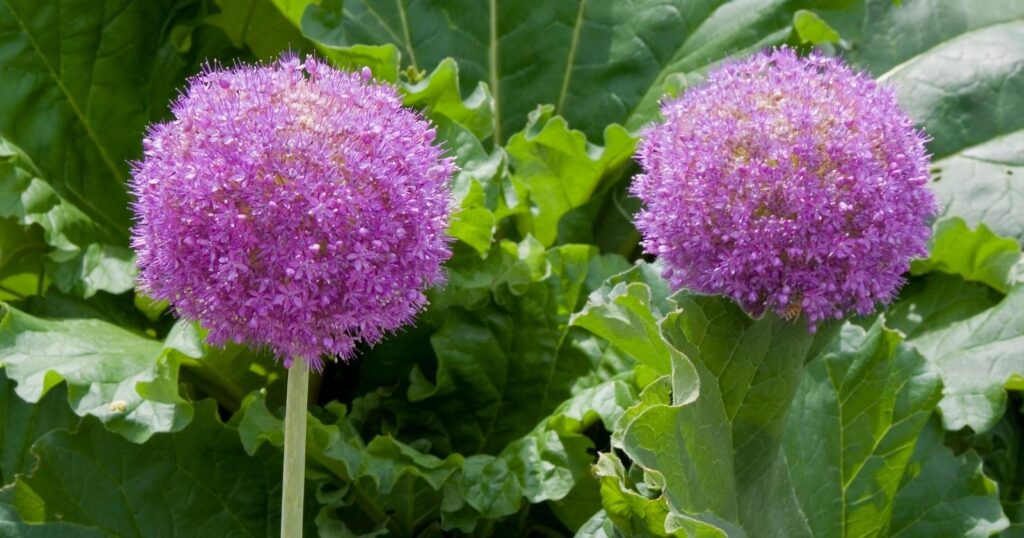
Scientific name: allium
- Sun Exposure: Full Sun
- Height When Mature: 1-6 feet
- Soil pH: 5.5-6.5
- Plant Zone: 4 to 10
Allium might be my favorite. It is a bulb that needs to be planted in fall. In spring they grow up and look like purple lollipops hovering through the garden. What I really love about allium is they don’t take long to mature. You plant a bulb and boom, the next spring you have a big blossom. They are reliable and add a touch of garden whimsy.
They need to be planted in full-part sun. Too much shade and they will sprout foliage on the bottom, but never bloom. They like moderate water and any garden soil.
The thing about allium is that they grow foliage low on the ground and then sprout up a single stem and big purple orb. The foliage down below will already be turning yellow by the time the flower blooms. So the trick is to hide this ugly foliage.
Or you can clip it and leave the flower stem. I like to plant allium in hostas, peonies, Annabelle hydrangea, or any other bushy perennial or ground cover that can hide the bottom foliage. Then it just looks like hovering purple lollipops through the garden.
‘Gladiator’ and ‘Ambassador’ are two of my favorite varieties. The bulbs are large and they grow huge balls of purple perennial flowers. These add instant impact in a spring garden. Allium is a popular perennial in hardiness zone 5, as well as hardiness zone 6.
‘Angelina’ sedum
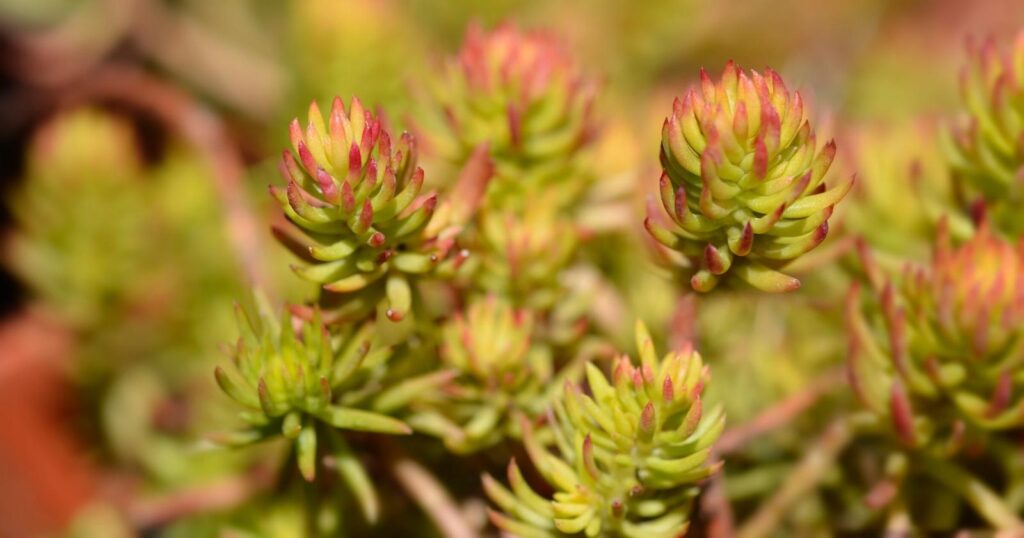
Scientific name: Sedum rupestre ‘Angelina’
- Sun Exposure: Full sun
- Height When Mature: 4ft tall, 24″ wide
- Soil pH: 6.0 to 7.0 (slightly acidic to neutral)
- Plant Zone: 5 to 9
Another sedum variety I just love is ‘angelina’ sedum. This bright green evergreen ground cover looks great in full sun perennial gardens. I especially love it creeping through rock gardens. It can also be used as an alternative to grass. When it first emerges in spring it is a fiery orange color that looks like fall in spring. Then it settles into a bright chartreuse color. It blooms yellow flowers in the summer months.
I love putting Angelina sedum into pots as a spiller plant. You can dig it out of the ground, put it into a pot, and then put it back into the ground in the fall. It transplants like a dream.
Annabelle Hydrangea
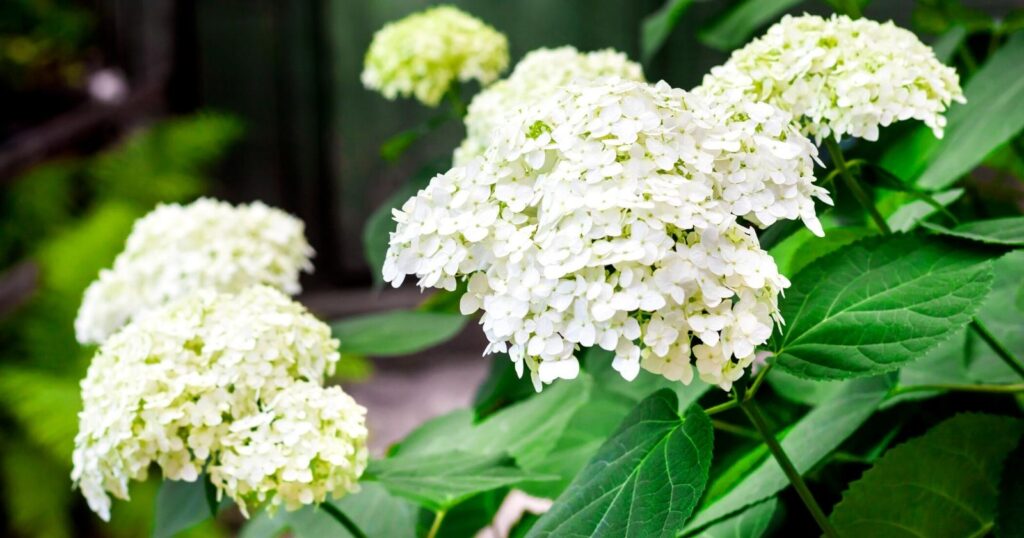
Scientific name: Hydrangea arborescens
- Sun Exposure: Full sun, Partial sun
- Height When Mature: 3′ to 6′
- Soil pH: 5.6 to 6.2
- Plant Zone: 3 to 9
Yes! Zone 3 gardeners can enjoy hydrangeas! There are actually a few varieties that are hardy in zone 3. But the Annabelle hydrangea is by far the most popular and spectacular. It has large round leaves and gigantic balls of white flowers composed of many tiny white flowers. Some of these blooms get as big as my hand across.
This large perennial is often touted as a shade plant, but I think in zone 3 gardens it does much better in part sun. I’ve seen them thrive in full sun, as long as they are getting tons of water. They grow best in nice moist, rich soil. Add plenty of organic matter to keep them growing.
Annabelle hydrangea flowers are so large they will most likely need staked. I like using half moon hoops to kind of prop them up and encase them. There is a variety called ‘Incrediball’ that has sturdy stems that can support the heavy balls of flowers.
Annabelle hydrangeas are very late to leaf out. Consider planting a spring bulb like allium or tulips in and amongst them to have some spring flowers before they take over later in the summer. Annabelle hydrangea might be slow to start, but once the flowers start they stay on the plant all the way into the winter. In fact I leave them up in the winter. The dried flower heads look great with sparkling snow on them.
‘Autumn Joy’ sedum
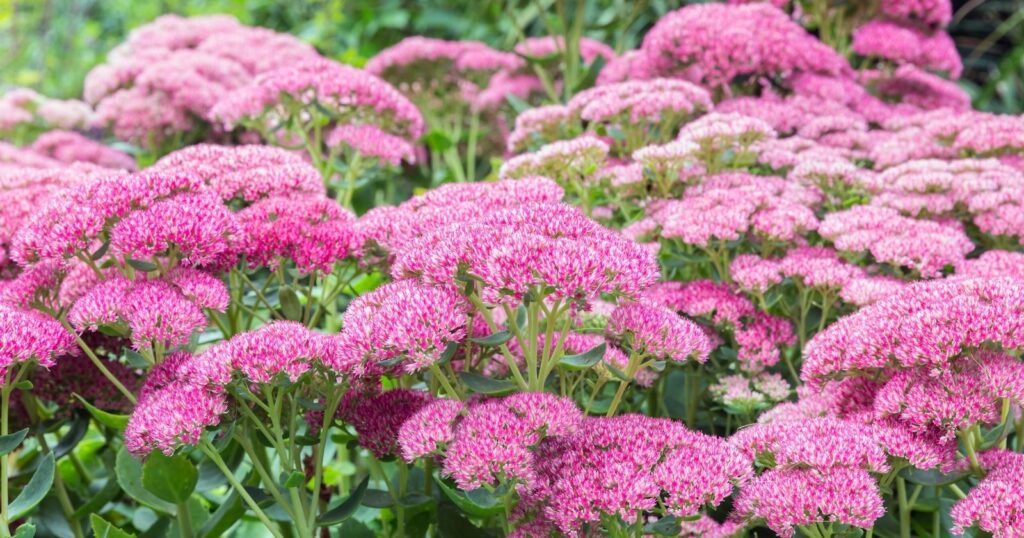
Scientific name: Hylotelephium spectabile ‘Autumn Joy’
- Sun Exposure: Full sun
- Height When Mature: 18 to 24 inches
- Soil pH: 6.0 to 7.5
- Plant Zone: 3 to 9
I love sedums. I have included a few on this list. But ‘Autumn Joy’ is such a unique variety I decided to give it its own place on this list. It is a neat perennial that stays in its place. It doesn’t really do much in the beginning of the season. Which is fine.
I find there are too many different flowers competing in late spring (peony, Iris, allium to name a few). So having a plant that stays in the background until late summer works. It’s flowers look like the head of a cauliflower and then in late summer through fall the cauliflower head of flowers blushes red.
It is an easy, virtually no maintenance perennial that only needs full sun and loose well draining soil to survive.
Balloon Plant
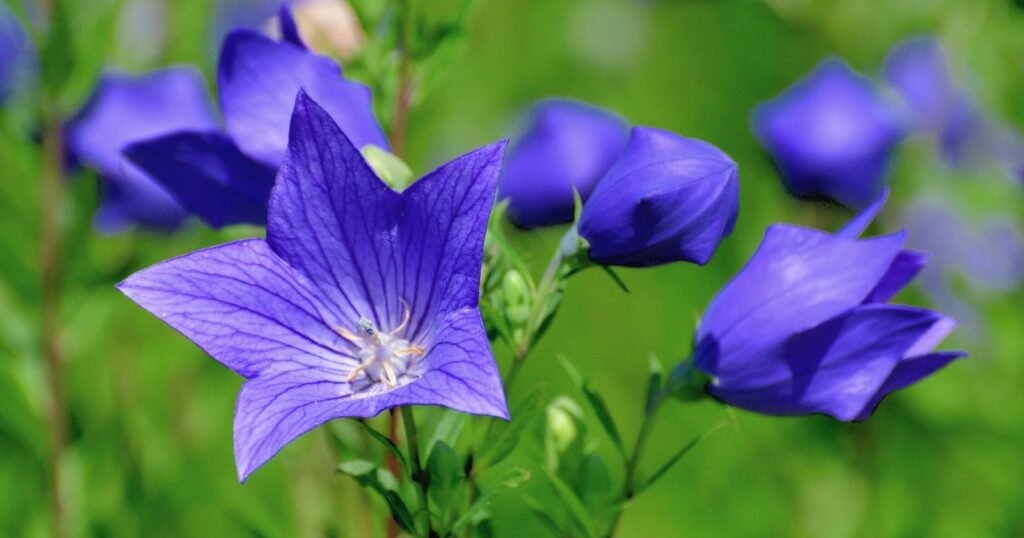
Scientific name: Platycodon grandiflorus
- Sun Exposure: Full sun or Part shade
- Height When Mature: 30″ tall
- Soil pH: 5.5 to 7.5
- Plant Zone: 3 to 8
Balloon plant is a special flower. It is small and needs to be closer to the front of a bed to be noticed. It blooms in late summer-early fall. It likes sun-part shade and nice rich soil. It is a tidy perennial that stays in its place.
Why this flower is so special is how it opens. It blows up into a perfect parcel and then the center bursts into a pretty star-shaped flower. I usually see them in purple, but I’ve seen white balloon flowers as well.
Bearded Iris
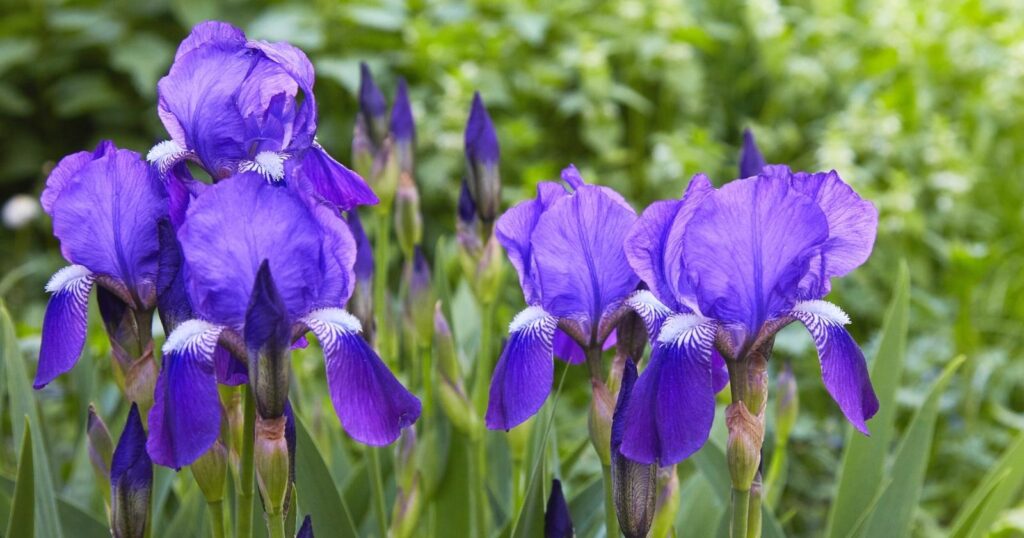
Scientific name: Iris × germanica
- Sun Exposure: Full sun
- Height When Mature: 2′ to 3′
- Soil pH: 6.5 to 7
- Plant Zone: 3 to 10
I always include irises in my gardens. I love the sharp spiky foliage and big unmistakable flowers.
They feature 3 petals drooping down and the rest folding up. They come in all sorts of heights and colors. Some are ruffled on the edges, others are small and neat. They come in deep purples, soft pinks, bright yellows, and almost every shade in between.
Iris are one of the first plants up and out of the ground in the spring. They like full-part sun and dry sandy soil. Don’t plant irises too deep. They will not bloom. The rhizomatous tubers must be at soil level.
I like using irises in mixed borders, they add structure with their spiked foliage and softness when they open their frilly flowers.
Bee Balm
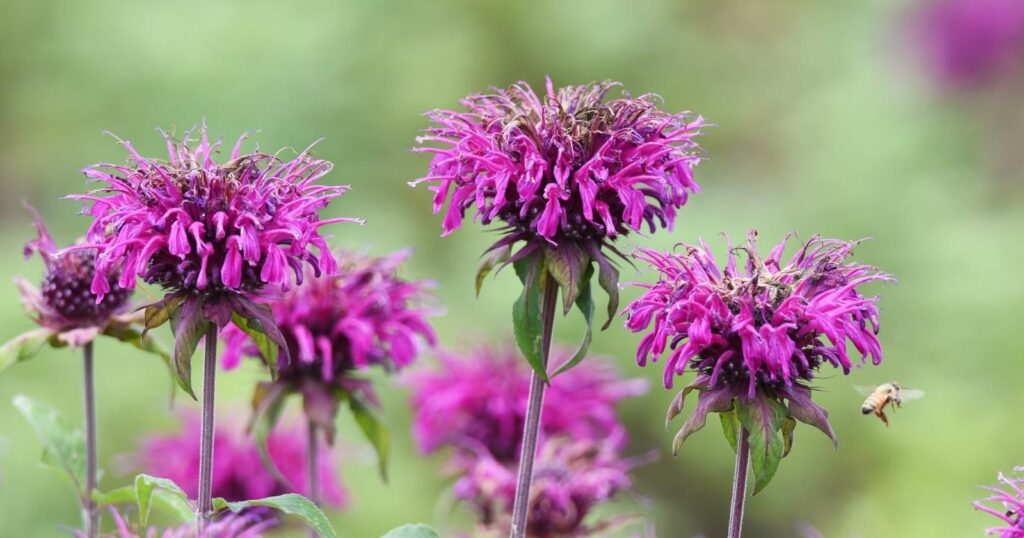
Scientific name: Monarda didyma
- Sun Exposure: Full sun
- Height When Mature: 3′ to 4′
- Soil pH: 6.0 to 6.7
- Plant Zone: 4 to 7
This shaggy scented plant is a wonderful addition to zone 3 gardens. It is a good border perennial. It blooms in the summer. They come in a variety of colors now. Red is the common variety. The flower heads look like muppets with shaggy tops and collars.
The leaves smell like bergamot and make a great tea. It also attracts bees and pollinators like crazy! They like part sun conditions and rich well draining soil.
‘Bubblegum Blast’ monarda is a variety I am currently obsessed with. It is shorter than the typical red variety and it stays in its neat little mound. The pink color of the fluffy flowers is vibrant and they last a long time. I plant pops of these in my perennial garden for a summer pop of color.
Bergenia
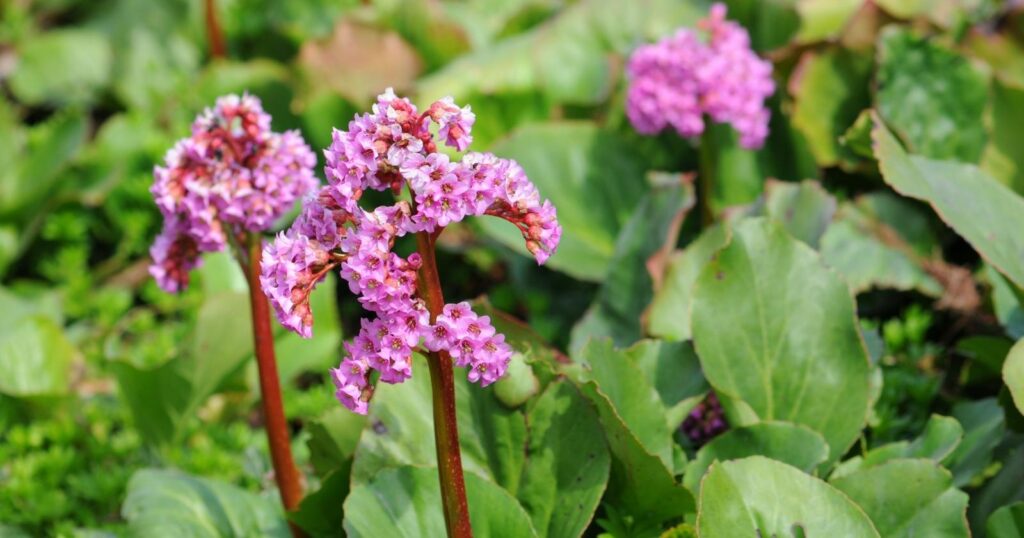
Scientific name: Bergenia cordifolia
- Sun Exposure: Full sun to Parital sun
- Height When Mature: 1′ to 2′
- Soil pH: 7.5 or above
- Plant Zone: 3 to 8
Bergenia is often known as elephant ear, but I don’t use this common name often as there are many other plants known as elephant ear. This glossy growing evergreen perennial is perfect for zone 3 gardens. In winter a lot of perennials die back to the ground, leaving bare earth all winter long (let’s face it in zone 3 we have a lot of winter to get through). So having glossy green bergenia leaves up is a welcome sight year round.
Bergenia is a simple perennial. It does best in shade-part sun conditions. It is another perennial that will tolerate dry shade. So they can go under spruce trees and in other dry shady conditions.
They bloom thick stalks of pink flowers in the spring. If they are planted in a mass they look spectacular. Then they remain green and glossy through the rest if the season.
If the leaves start looking tattered and ratty, just clip them back, they flush up fresh new ones.
This is a good deer resistant alternative to hosta. Deer don’t munch the leathery leaves of bergenia. But they will happily munch the flowers off.
Blanket flower
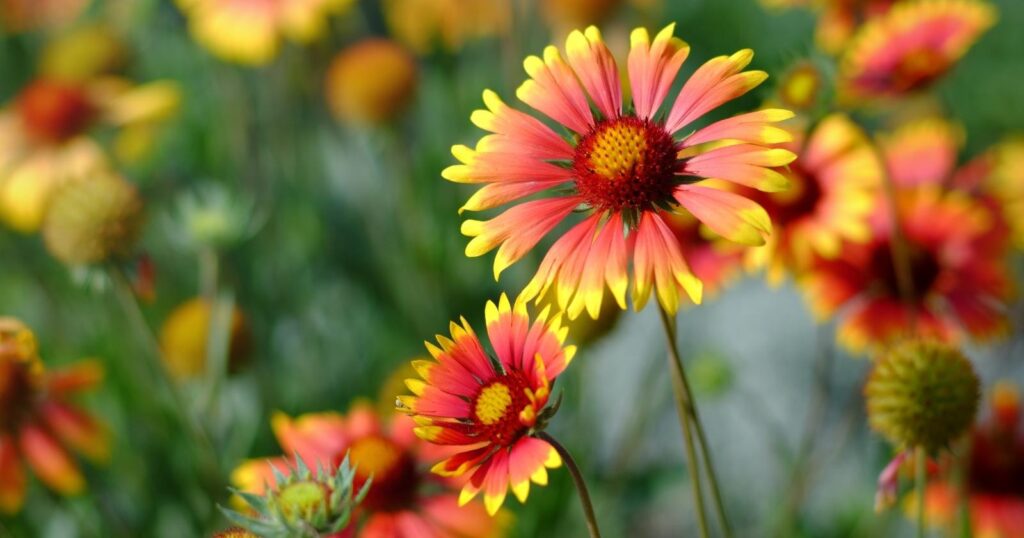
Scientific name: Gaillardia
- Sun Exposure: Full sun
- Height When Mature: 12″ to 18″
- Soil pH: 5.5 to 7.9
- Plant Zone: 3 to 10
I love hot colors in the garden. Blanket flowers are on fire. They are daisy like flowers that come in shades of red, range, and yellow. The flowers are very intricate and usually include a variety of colors in an ombre pattern. They are a nice mounding perennial that will slowly spread outwards. They like full sun and light well drained soil.
What I really love about this perennial is it starts blooming in the summer and just keeps blooming. You can deadhead the blossoms to encourage more blooms. Or you can leave the center orbs on the flower after the petals fall off. I think both look good.
Blazing Star
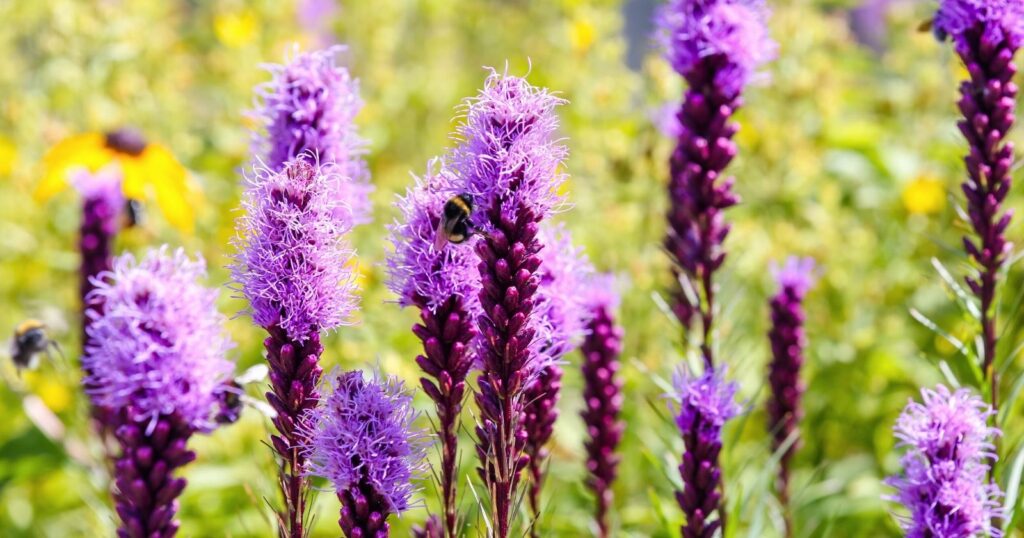
Scientific name: Liatris spicata
- Sun Exposure: Partial-Full sun
- Height When Mature: 2′ to 4′
- Soil pH: 5.5-5.8
- Plant Zone: 3 to 9
Blazing star is a simple but beautiful summer blooming perennial. It has mounded grassy green foliage. In the late summer it shoots up purple or pink stalks of fuzzy flowers. It looks like a blazing star because the bottom fades as the top grows higher and fluffier like a shooting star.
Blazing stars like sun-part sun locations and well draining soil. I like adding pops of them to mixed perennial beds. The grassy foliage is a nice texture contrast and then the later blooming flowers are a welcome sight.
Bleeding Heart
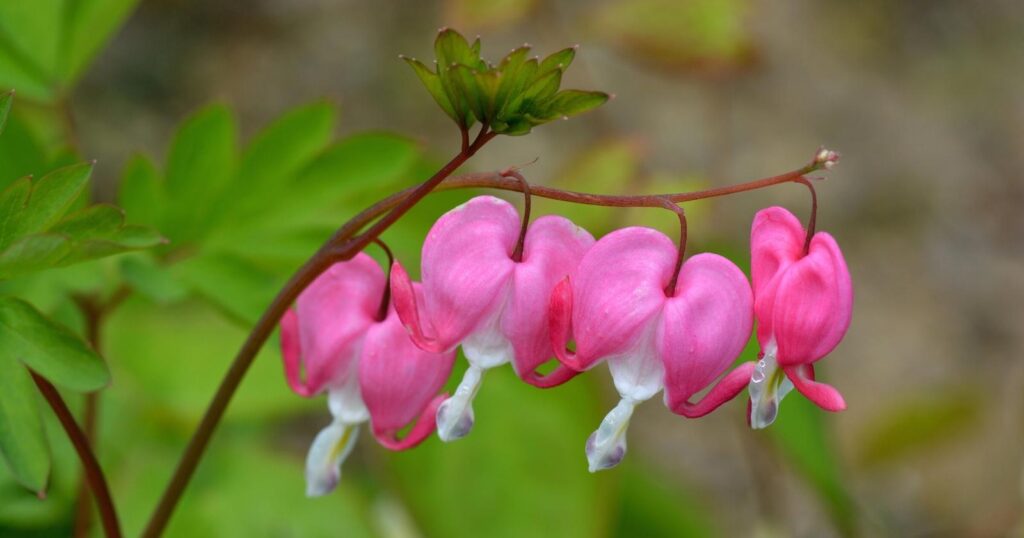
Scientific name: Lamprocapnos spectabilis
- Sun Exposure: Shade to Partial sun
- Height When Mature: 24″ to 36″ tall
- Soil pH: 6.0 to 6.5
- Plant Zone: 3 to 9
Bleeding heart is a wildly popular perennial. With good reason too. It has a lovely mounded form with lacy foliage and strings of heart shaped flowers that bloom in early spring.
I love how bleeding heart rises out of the ground in very early spring and can get very large and bushy before the other shade plants like hostas and ferns even begin to poke out. They grow best in part shade-shade and like moist fertile soil.
After They bloom however, they start to fizzle out fast. For this reason, I like to plant them in and amongst other things in the garden and not as a stand alone feature. If you plant a bleeding Heart by itself in a garden it will look amazing until about mid July, then it turns yellow and dyes, fast.
I like planting it in and around other plants so that I can simply clip it down and have other perennials like ligularia, bugbane, or hostas take over for the remainder of the season.
Blue Trumpet Gentian
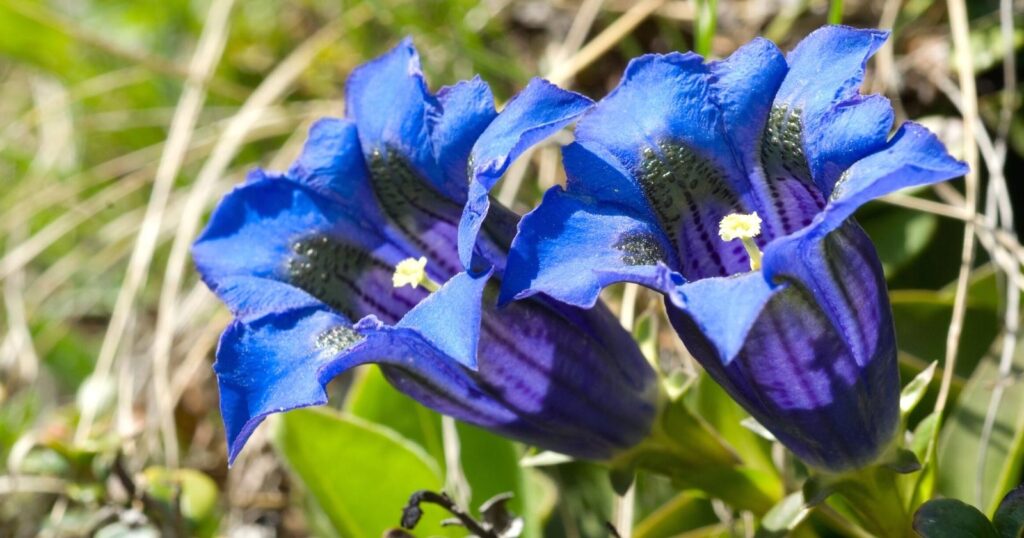
Scientific name: Gentiana acaulis
- Sun Exposure: Full sun to Partial sun
- Height When Mature: 3″ tall
- Soil pH: 5.5 to 6.5
- Plant Zone: 3 to 7
Blue trumpet gentian will steal the show in your garden. True blue is the rarest color in the garden. Most ‘blue’ flowers are more of a purple color. But blue trumpet gentian is an electric blue color. This low growing ground cover blooms in late spring-early summer. They do best in full-part sun. They like well draining loose soil.
Plant these flowers in your front garden borders for a spectacular display. People walking by will comment on them constantly because they are less common and such an unbelievable intense blue color.
Bugbane
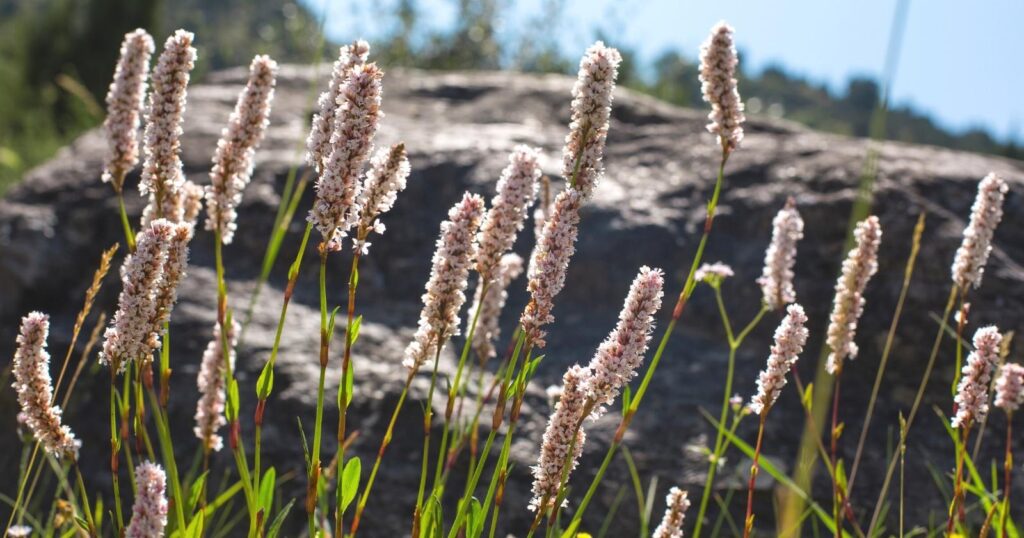
Scientific name: Actaea racemosa
- Sun Exposure: Sun, Partial shade to Full shade
- Height When Mature: 4′ to 6′ tall
- Soil pH: 5.0 to 6.0
- Plant Zone: 4 to 8
Bugbane is a beautiful fragrant fall flower. It also has dark lacy burgundy foliage making it an interesting addition to the garden in spring and summer too. The flowers are so interesting. They are long spikes of fluffy light pink flowers. I especially love the buds before they open. Perfect burgundy spheres on long curving stems.
Bugbane is known as a shade flower, but I find it gets bigger and flowers earlier (which is important since zone 3 falls are so short) in part sun.
‘Black Negligee’ is the variety I recommend. This perennial is tall and flowers, where some other varieties never seem to make it to that stage in zone 3.
Butterfly Milkweed
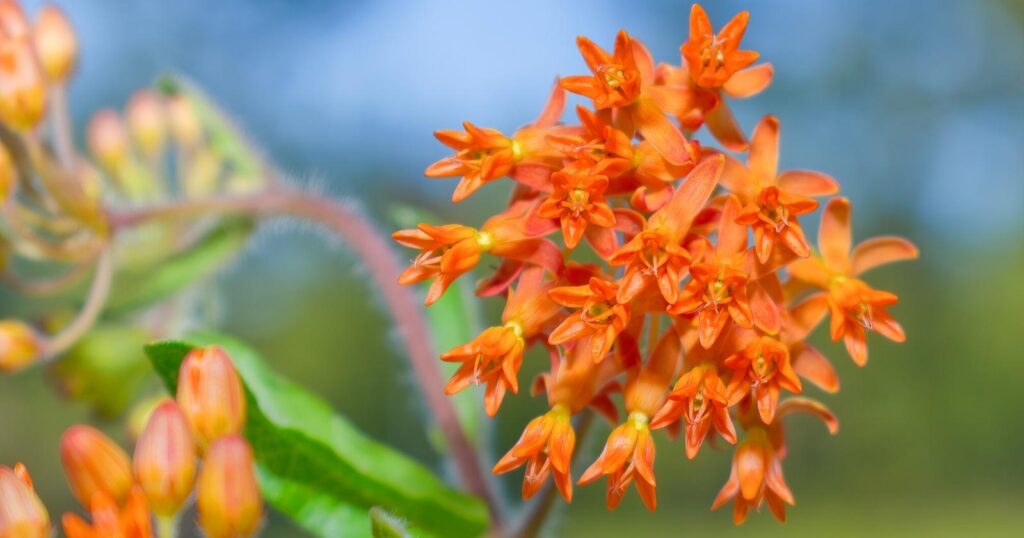
Scientific name: Asclepias tuberosa
- Sun Exposure: Full sun to Partial sun
- Height When Mature: 1′ to 2.5′ tall
- Soil pH: 6.0 to 7.0
- Plant Zone: 3 to 9
If a pollinator garden is your goal, be sure to include butterfly milkweed. These bright orange clusters of flowers attract butterflies. It is a drought tolerant, full sun perennial that looks great in wildflower, cottage, and pollinator gardens. It blooms continuously through the summer. As a bonus, this perennial is easy to grow from seed so it’s an inexpensive plant to add to your garden.
Candytuft
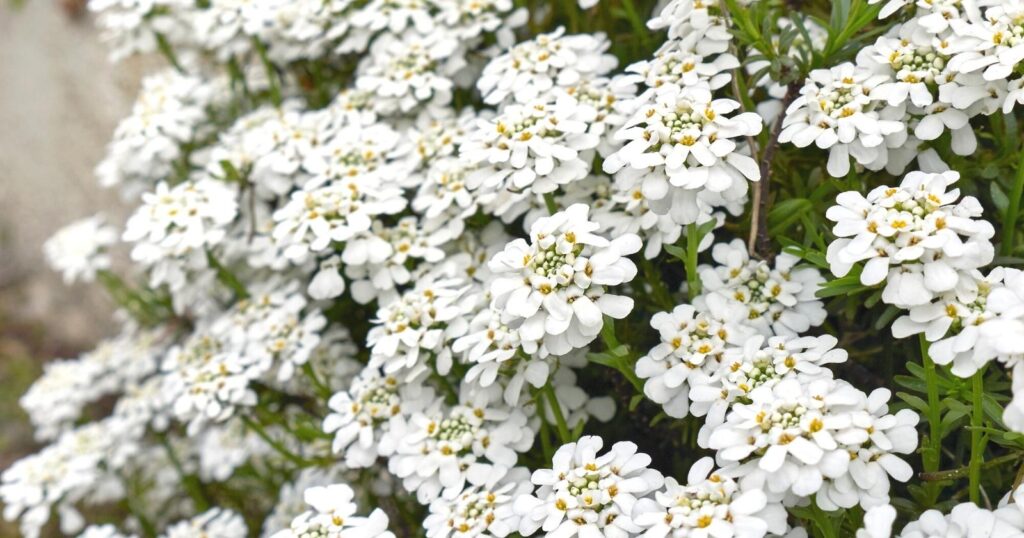
Scientific name: Iberis sempervirens
- Sun Exposure: Full sun
- Height When Mature: 6″ to 12″ tall
- Soil pH: 6.0 to 7.5
- Plant Zone: 3 to 9
Candytuft is an evergreen ground cover. When I first came across it in the summer, I was less than impressed. It’s kind of scraggly, I couldn’t figure out why anyone would choose this perennial. But then when I discovered it in the early spring, it hit me. It is covered in balls of white flowers.
There aren’t very many zone 3 perennials that bloom in the early spring. That’s when snow is not quite melted and things aren’t quite ready to emerge. But candytuft is already out of the ground and blooming first thing.
Candytuft likes full sun and well draining soils. I like planting it in rock gardens where it can creep and spill into all the crevices and nooks.
Catmint
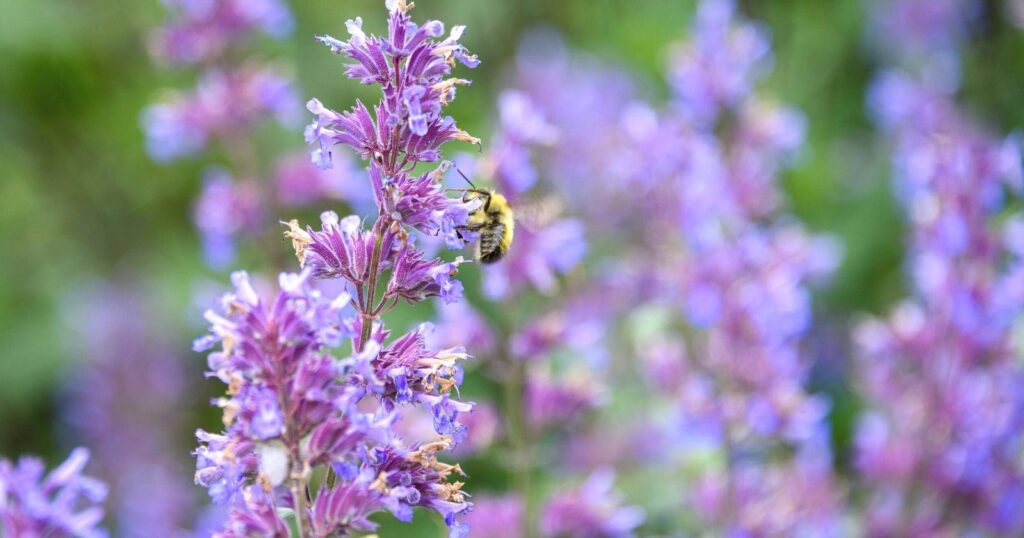
Scientific name: Nepeta racemosa
- Sun Exposure: Full Sun, Partial Sun
- Height When Mature: 12″ tall, 18″ wide
- Soil pH: 6.0 to 7.0
- Plant Zone: 4 to 8
Catmint is another solution to lavender in zone 3 gardens. It is a low bushy perennial that has a strong soapy, lavender smell. It blooms purple sprays of flowers in the summer.
Catmint Iikes hot, dry, sunny conditions. I love seeing it planted along garden pathways. It has a very soft English garden feel.
While catmint doesn’t really spread, one plant will grow very wide and take up a lot of space. You may need to split it often to keep it under control. Do this in early spring or fall.
Cheddar pinks
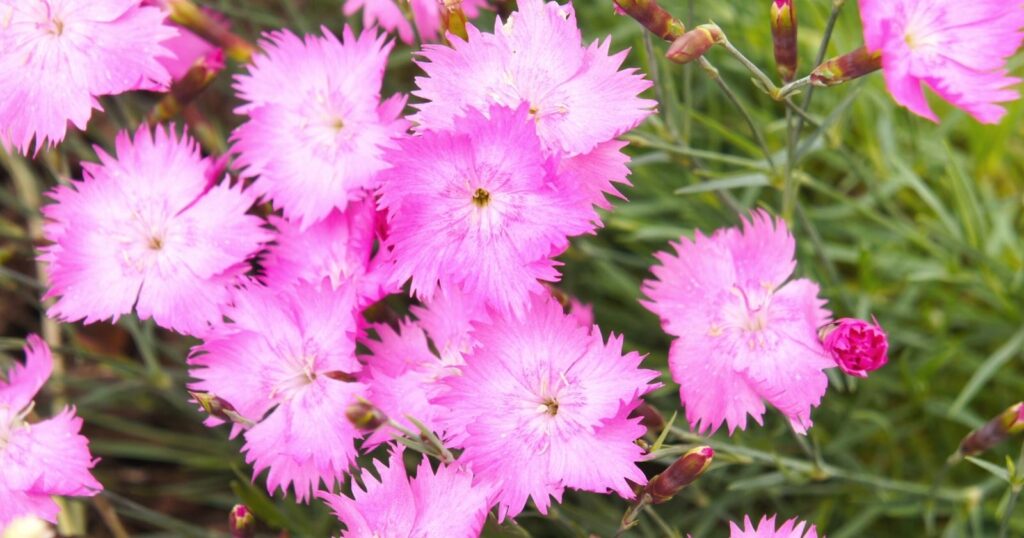
Scientific name: Dianthus gratianopolitanus ‘Grandiflorus’
- Sun Exposure: Full sun
- Height When Mature: 6″ to 12″ tall
- Soil pH: 6.6 to 7.5
- Plant Zone: 3 to 9
Cheddar pinks are a joyful evergreen ground cover. They have silver sort of spiky evergreen foliage. It is attractive year round. But when summer hits it explodes into a carpet of pink. Small star shaped flowers cover the plant.
It likes full sun and well draining soil. It looks great in a rock garden where it flows over the rocks like a carpet. it spreads, but not aggressively.
Chives
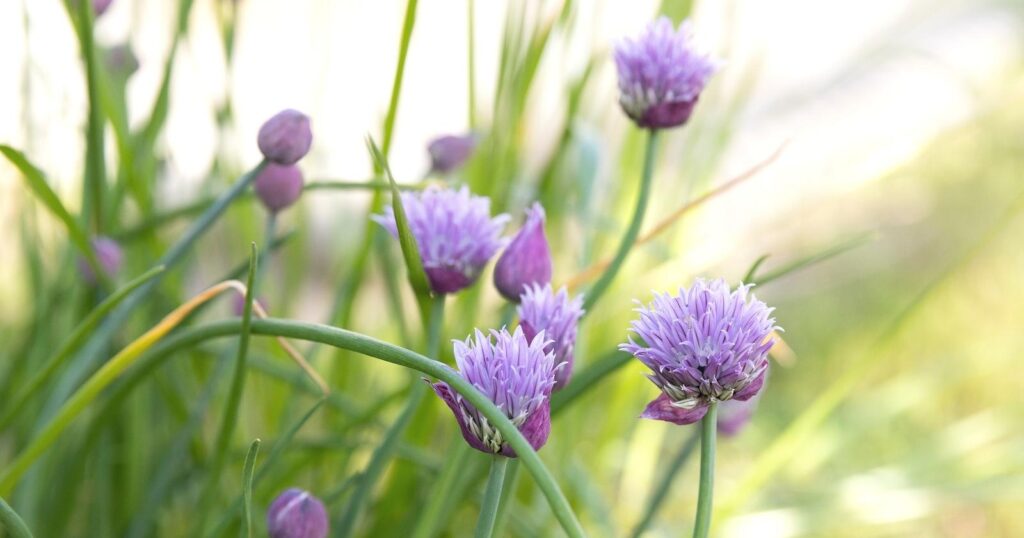
Scientific name: Allium schoenoprasum
- Sun Exposure: Full sun, Partial sun
- Height When Mature: 1′ to 2′ tall
- Soil pH: 6.0 to 7.0
- Plant Zone: 3 to 9
Well, they may not be glamorous, but good old chives are a reliable zone 3 perennial herb. It’s a small plant that comes up in spikes in the early spring. Clip it and put it in potatoes and eggs. They are delicious. Then they bloom purple balls of flowers.
These are also delicious in soups and salads. Just beware of the seed heads from these flowers. I usually pull them off just as they are starting to turn brown. If you let them go you will have chives everywhere.
Chives grow easily. Sun-part shade. They don’t care about soil, and don’t need any extra water. I know some people only put them in herb gardens, but these grassy mounds are an attractive plant in borders.
Columbine
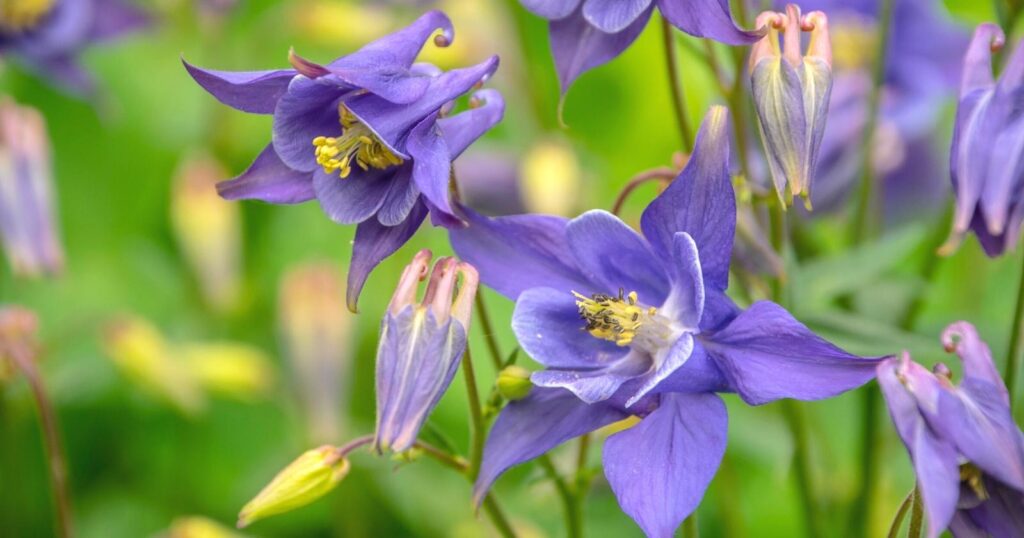
Scientific name: Aquilegia
- Sun Exposure: Full sun, Partial shade
- Height When Mature: 15″ to 20″
- Soil pH: 5.5 to 5.8
- Plant Zone: 3 to 9
Columbine is a lovely group of flowers. They have interesting round foliage and flowers that look like a dragon’s head and then they open up to a unique tropical looking flower. They come in so many different colors and shapes. There are single flower and double flowering varieties.
They like sun-part sun conditions. These flowers are avid self seeders and movers and shakers. If you like every plant in its place this is not the plant for you. But if you like a more cottage style wild garden where every space is filled with something, then columbine is a welcome addition to your garden.
Common Spiderwort
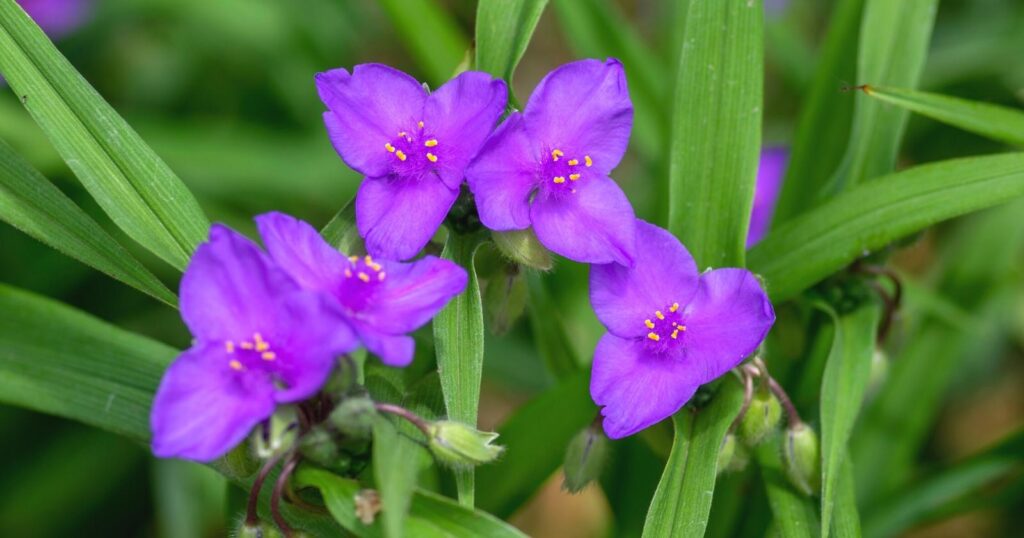
Scientific name: Tradescantia virginiana
- Sun Exposure: Partial sun
- Height When Mature: 1′ to 3′ tall
- Soil pH: 6.8 to 7.2
- Plant Zone: 4 to 9
Spiderwort may not have the prettiest name, but it is a dainty little flower. It grows in sun-part shade gardens. I like the grassy shape of the foliage in and amongst more rounded leafed plants (hostas, brunnera etc).
It has small purple three petaled flowers that last a long time. It’s not the most spectacular plant, but when combined in a garden it is a sweet little surprise. Or it can be planted in a mass for a more dramatic effect.
Coneflower
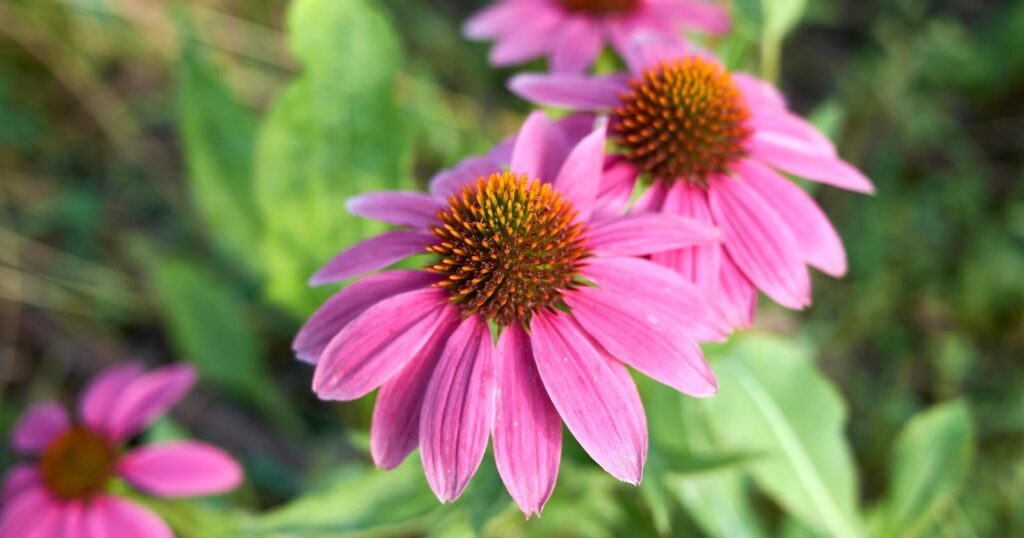
Scientific name: Echinacea purpurea
- Sun Exposure: Full sun
- Height When Mature: 2′ to 4′ tall
- Soil pH: 6.0 or greater
- Plant Zone: 4 to 9
Coneflower is a great transition flower for zone 3. It appears in mid-late summer and sticks around until fall. These flowers are great for planting in and amongst the garden. In the spring when all the peonies, iris, delphinium etc are stealing the show, coneflower just blends in with the garden. Then after those flowers have finished blooming, coneflowers appear and steal the show.
They like full sun and well draining soil. Pink is the classic color for coneflower, but they come in red, yellow, and white too. They even come in double flowering varieties where the center is a fluffy mass of petals.
Creeping Jenny
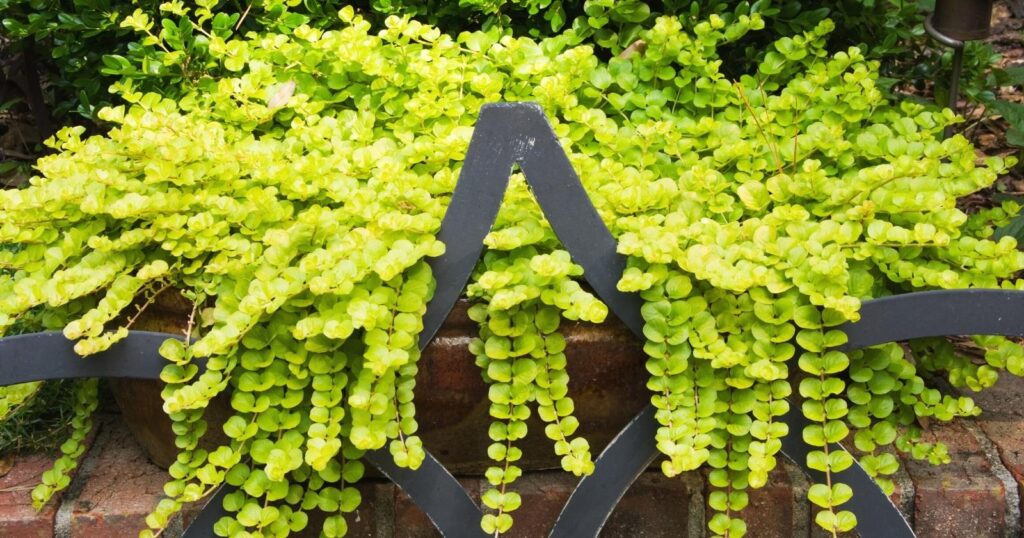
Scientific name: Lysimachia
- Sun Exposure: Full sun, Partial sun
- Height When Mature: 6″ to 12″ tall
- Soil pH: 6 to 7.8
- Plant Zone: 4 to 9
Creeping Jenny, is an aggressive ground cover that looks great in zone 3 gardens. I’m constantly admiring the lushness of a zone 5-7 coastal garden. They are so green and lush. I find myself trying to recreate that look here in my zone 3 garden.
Lysimachia is great for that. It creeps all along the ground of garden beds, in part sun-shade conditions. I plant it around the base of hostas, ferns, and brunnera. It creates a lush base for other things to grow out of. It also acts as a natural mulch that keeps the moisture in the soil.
If you find it in areas you don’t want it growing, I find it not too difficult to dig up or pull.
Golden creeping Jenny is my go to. I love the way it trails out of containers, and brightens shady areas in the garden. The bright chartreuse foliage is the perfect contrast to all the green in a garden.
Daylily
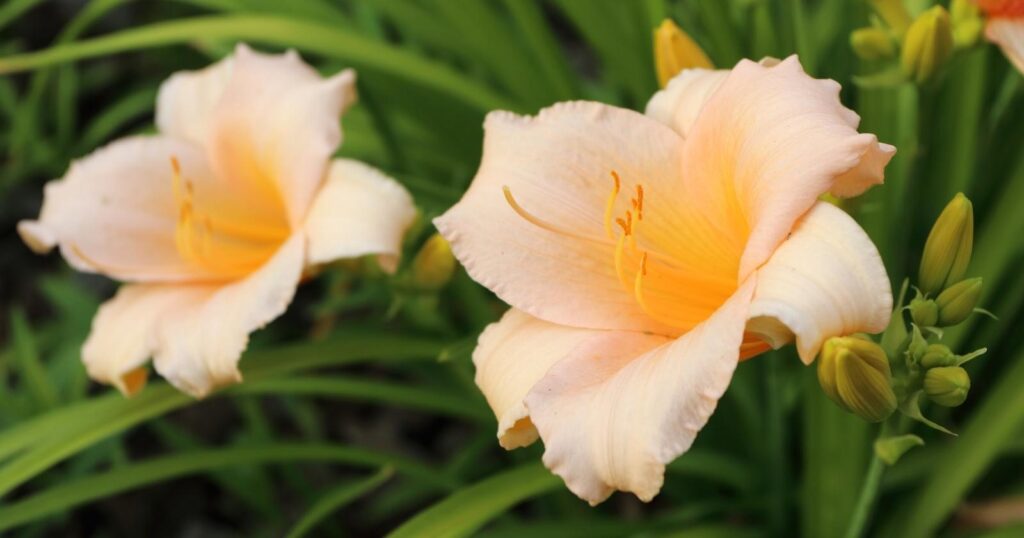
Scientific Name: Hemerocallis
- Sun Exposure: Full sun, Partial shade
- Height When Mature: 1′ to 4′ tall
- Soil pH: 6 to 6.5
- Plant Zone: 2 to 11
Day lilies are a garden staple. I love their grassy structure and beautiful sprays of flowers. They do great in full-part sun to part shade gardens, making then extremely versatile. They like well draining soil.
Plant them in mixed borders to soften the landscape with their grassy foliage. There are so many varieties to choose from. I recommend going to the garden center and finding one you love. Beware of common daylily. This is an orange flower variety. It will travel and go crazy. The newer hybrid varieties stay in there place
‘Stella D’oro’ is my go to day lily. It has orange flowers that bloom constantly throughout the summer. They have finer foliage than other varieties of daylilies and stay put in their neat mounds.
‘Peach Candy’ is a lovely peachy colored daylily with a dark ring in the center. I love how it looks like a tropical flower.
Delphinium
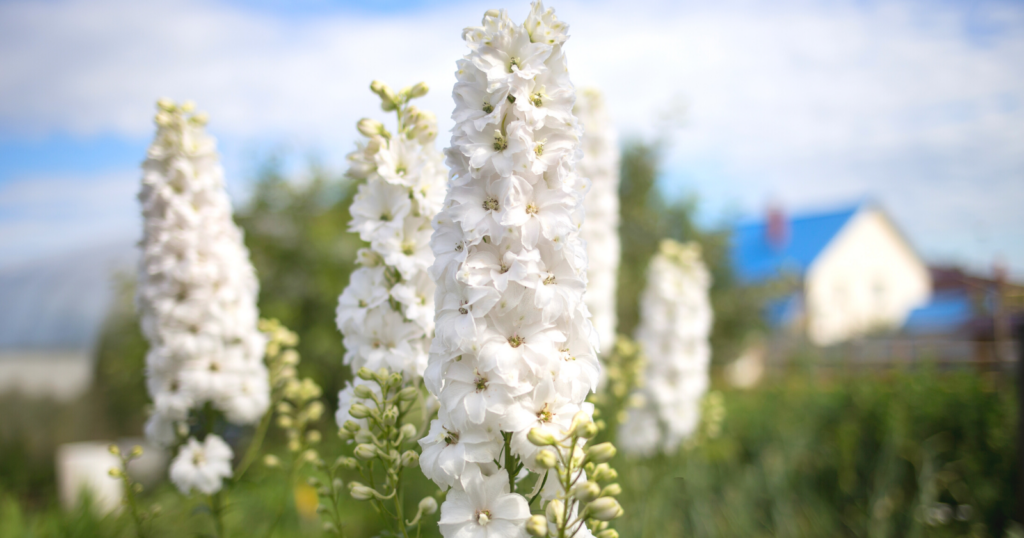
Scientific name: Delphinium
- Sun Exposure: Full sun
- Height When Mature: 6 feet
- Soil pH: 6.5 to 7.0
- Plant Zone: 3 to 7
What would a zone 3 perennial list be without delphinium? This is a garden mainstay for cold climate gardeners.
Delphiniums grow best in full-part sun and like rich, well draining soil. They grow spires of flowers in colors ranging from true blue, purple, white, and even red.
They bloom in late spring-early summer and make beautiful background plants. Just as the peonies start to fade they kick in and take over the garden show.
There are lots of varieties of delphinium. The tall varieties will require staking. You can get cages, I like the taller 3 ringed ones to really keep them upright. Get these on in the early spring and they will grow up through them. Or you can use bamboo stakes and string. If this isn’t your thing, not to worry, there are plenty of dwarf varieties that have the same lovely delphinium flowers, but don’t require staking.
‘Finesse’ Leopard’s Bane
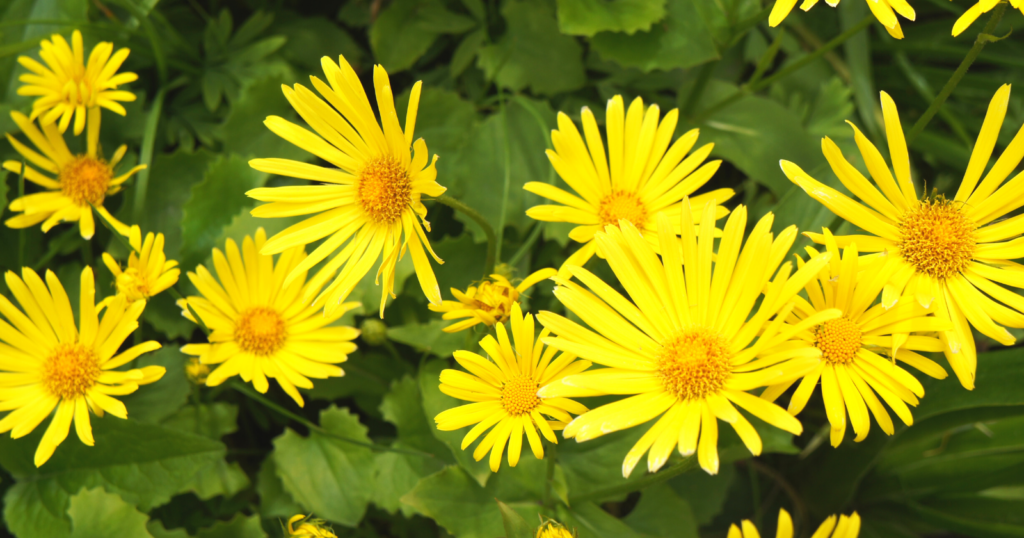
Scientific name: Doronicum orientale ‘Finesse’
- Sun Exposure: Partial shade to Full sun
- Height When Mature: 12″ to 18″
- Soil pH: 6.0 to 6.5
- Plant Zone: 4 to 8
This low growing spring blooming perennial is a great addition to a zone 3 garden. This full-part sun perennial likes rich moist soil. It grows low and is a great little perennial for garden borders. It fills the gap in blooms that happens after the early spring blossoms finish and before the peonies bloom.
It’s bright yellow daisy-like blooms are bright and cheerful. Then after they are finished blooming they are little mounds of green with jagged heart shaped leaves.
Geum
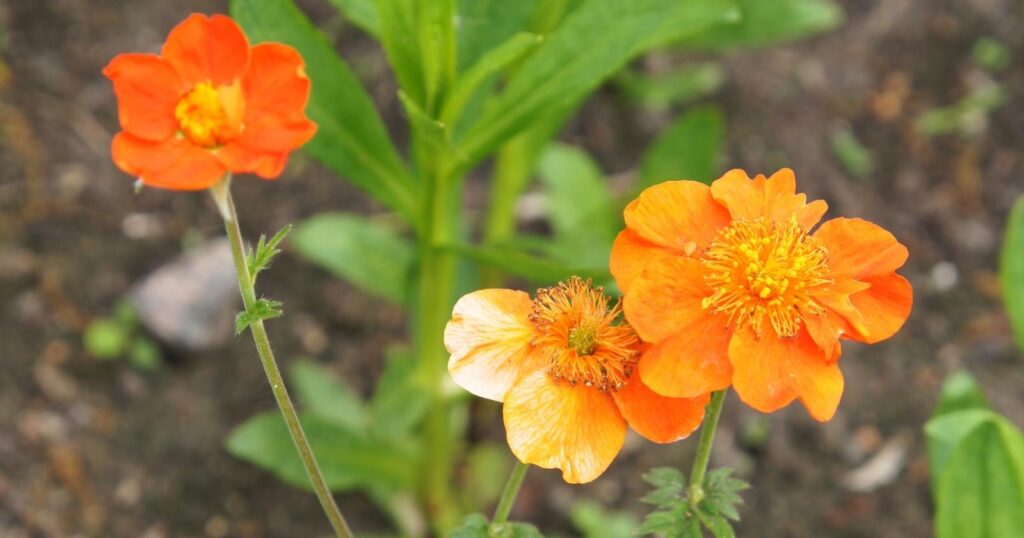
Scientific Name: Geum
- Sun Exposure: Full sun to Partial sun
- Height When Mature: 12″ tall by 18″ wide
- Soil pH: 5.8 to 6.4
- Plant Zone: 4 to 11
I think geum is an underused gem in gardens. It is a low growing and spreading (but not aggressive) perennial. It likes part sun/shade conditions. It is perfect for pops of color in a front border.
Geum blooms beautiful orange flowers that rise from the plant on thin stems. It blooms in spring, and if the weather holds, it will bloom. A second smaller flush in the fall. They like part sun and lush well draining soil.
‘Prairie Smoke’ is a variety I see on garden groups all the time. The picture of the seed pods wound up like cotton candy. This variety blooms smaller downward facing pink flowers. But the seed pods look like fluffy puffs of smoke.
Globe Flower
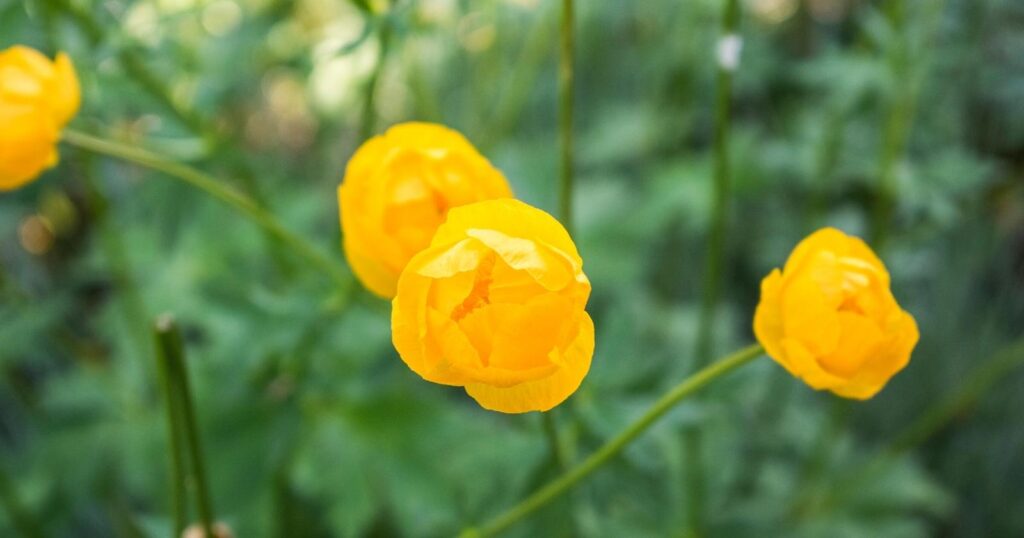
Scientific name: Trollius
- Sun Exposure: Full sun to Partial shade
- Height When Mature: 2′ tall 18″ wide
- Soil pH: 5.0 to 7.0
- Plant Zone: 3 to 7
The sunny orbs of orange and yellow are one of my favorite sights in spring. This full-part sun perennial likes nice rich evenly moist garden soil. I like planting pops of them throughout garden borders.
‘Golden Queen’ is a popular variety and it is a bit different from the classic orb shaped flowers of globe flower. This variety is taller, reaching 3 feet tall. The flowers are orange and feature a row of petals all around with really long graceful stamen reaching out of the center. This variety is showy enough to be a feature plant in a garden in the spring.
Globe Thistle
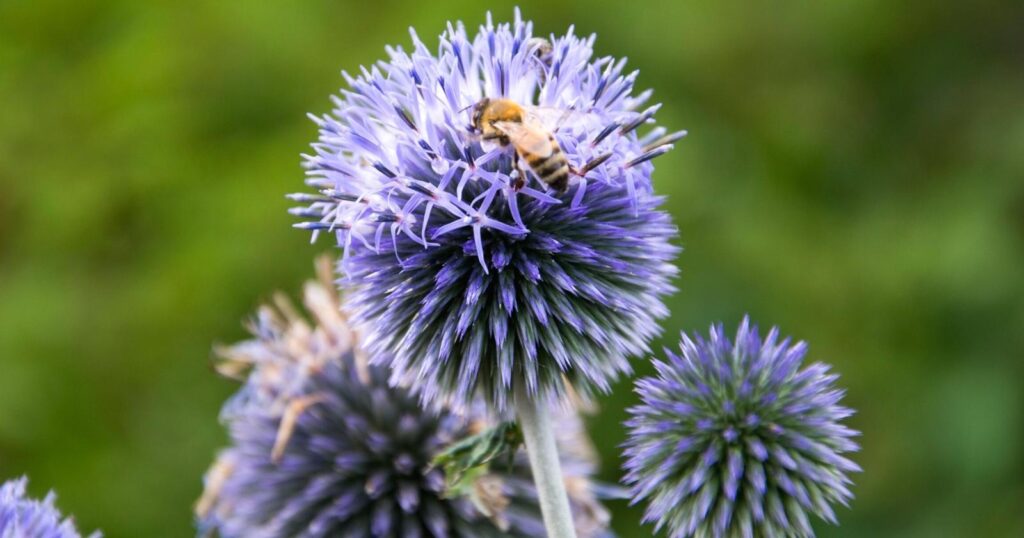
Scientific name: Echinops
- Sun Exposure: Full sun
- Height When Mature: 4′ tall
- Soil pH: 5.1 to 6.0
- Plant Zone: 4 to 8
Globe thistle is a great perennial that is gaining popularity. It is an easy full sun perennial. It likes little water and poor soil. It has silvery thistle like leaves and then it blooms these orbs of blushing purple spikes.
It does grow and spread quite a lot. I recommend this especially if you have a large area of garden you need to fill. It’s large and very structured so it has presence in a garden if it is planted in a distant garden bed.
The thistle balls on top are so unique and the bees love them. In the fall I clip some of them off and fill a decorative jar or bowl with them. They look great and stay intact indefinitely.
Grape Hyacinth
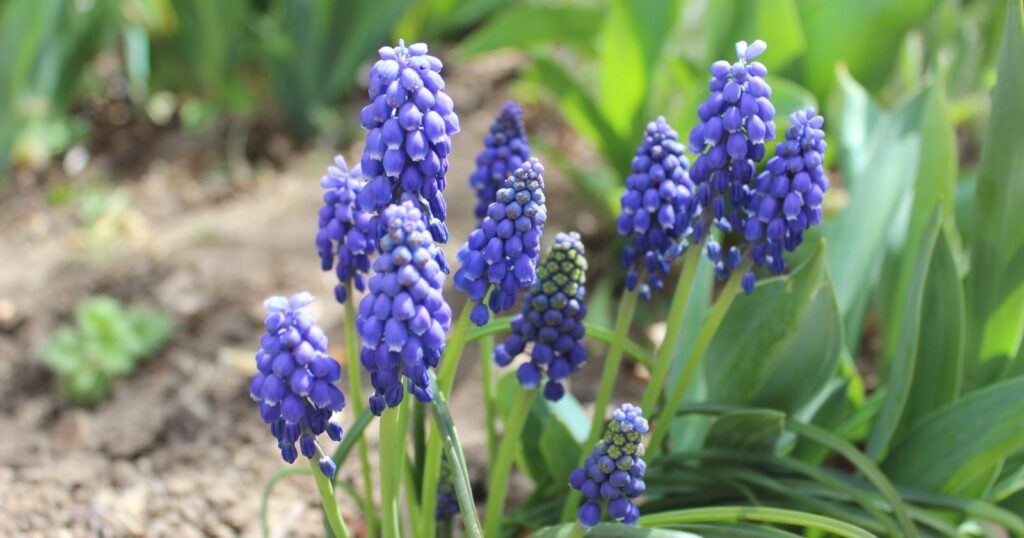
Scientific name: Muscari armeniacum
- Sun Exposure: Full sun, partial shade
- Height When Mature: 6-9″ tall, 3-6″ wide
- Soil pH: 4.5 to 7.5
- Plant Zone: 3 to 9
Grape hyacinth is a great little bulb to plant in the fall. They come up in the spring with tiny bluish purple bell shaped flowers on grassy mounds of foliage. This is another plant I like to tuck in and amongst all my plants that are later to emerge. Among hostas and Annabelle hydrangeas are great places to tuck these bulbs into. After the grape hyacinth blooms it just has grassy foliage that turns yellow by summer and can be gently pulled out.
Grape hyacinth grows best in full-part sun and nice rich garden soil.
One of my favorite tricks with grape hyacinth is to plant them in a flowing river through the garden. The flowers are short and small. Seeing one or two here and there doesn’t add much impact. But if you plant them in a mass you are left with a big hole in your garden in the summer.
If you plant them like a winding river through the front of your garden bed you get a big impact and then they disappear without leaving a single hole.
Hens and Chicks
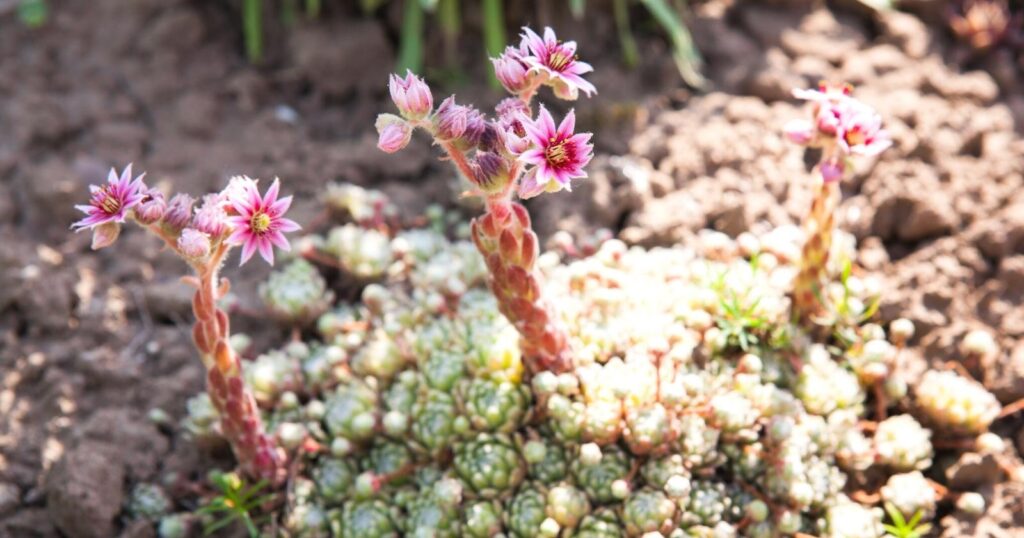
Scientific name: Sempervivum sp.
- Sun Exposure: Full sun, Partial shade
- Height When Mature: 4-8″ tall
- Soil pH: 6.6 to 7.5
- Plant Zone: 3 to 8
Hens and chicks are one of my favorite perennials. They are part of the stonecrop family, so they are definitely hardy to zone 3. They are low growing succulent-like plants that form little clusters. The ‘Hens’ being the bigger ones that have offshoots of smaller ones that are the ‘chicks’.
These plants grow in full-part sun and like dry well draining soil. They do bloom. A single hen or chick will start growing up and out and create this tall spire with spiky flowers in the end. It looks alien. This is the plant’s final show. After it blooms it will die. But that is only a sine hen or chick and there will be more that just fill in and take its place.
Hepatica
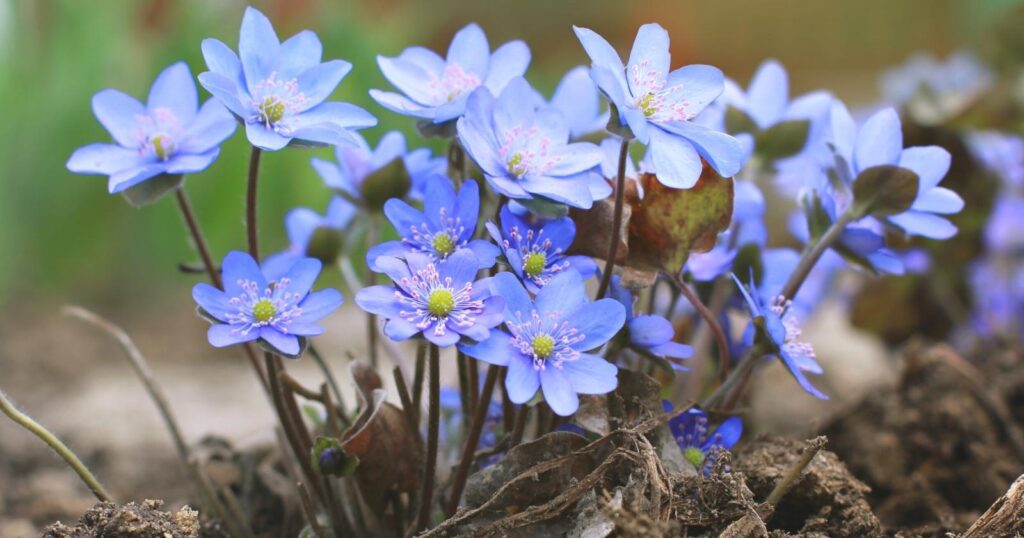
Scientific name: Hepatica nobilis
- Sun Exposure: Partial shade to Full shade
- Height When Mature: 6-9″ tall
- Soil pH: 5.5 to 6
- Plant Zone: 4 to 7
This sweet little perennial is one of my favorites. Sometimes in zone 3 it feels like winter will never end. Sometimes we experience the heaviest snowfalls in March and April. But hepatica is one of the first signs that spring is in fact coming.
This perennial blooms so early I sometimes miss it in my client’s gardens because it blooms before I even get there for spring clean up. In all the brown and dead foliage, little 4″ hepaticas are poking out with their 7 petaled purple flowers and dainty yellow center.
Then as the season goes on they stick around as little trilobed leaves in the garden. I like planting them in and amongst hostas, Annabelle hydrangeas and other perennials that are later getting out of the ground.
Hops
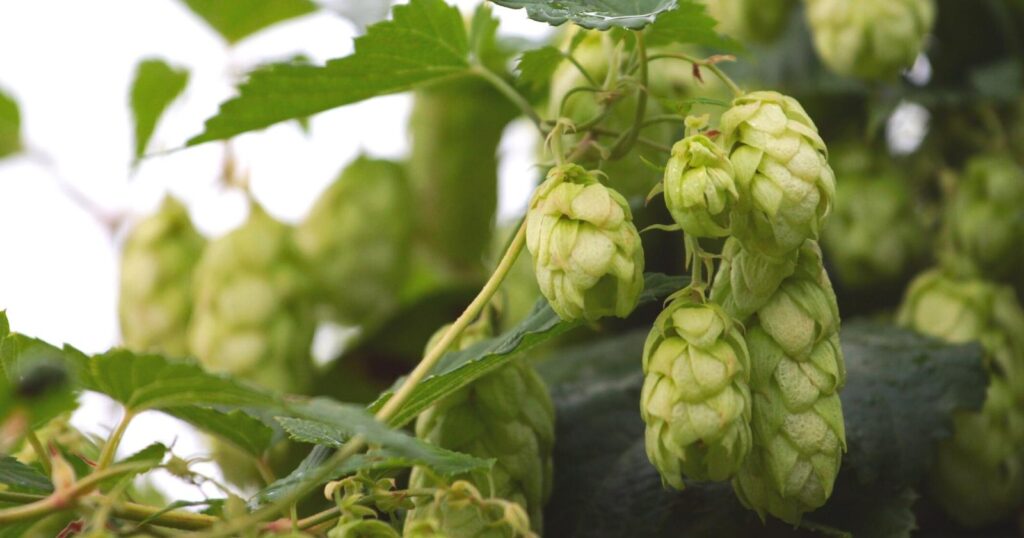
Scientific name: Humulus lupulus
- Sun Exposure: Full sun to Partial shade
- Height When Mature: 15-20′ tall
- Soil pH: 6.0 to 6.5
- Plant Zone: 4 to 8
Hops is one of my favorite zone 3 vines. I find getting things to climb in zone 3 a bit of a challenge. But hops makes it easy. Be careful, as it is aggressive. But if you want full coverage quickly, hops will do it. It is a climbing vine that will twine and stick itself to trellises and fences. Then in the late summer it will produce the Hops flower, which are technically called strobiles. This is what is used in beer making.
Hops likes full-part sun and once planted it is hard to get rid of. It does die back every winter and grows from the ground in spring. This might mean some extra maintenance because you’ll have to peel the dead hops from the structure it’s attached to to make room for the new growth.
‘Golden Hops’ is my favorite variety. It is a bright chartreuse color and creates the perfect backdrop for other plants to grow in front of.
Hosta
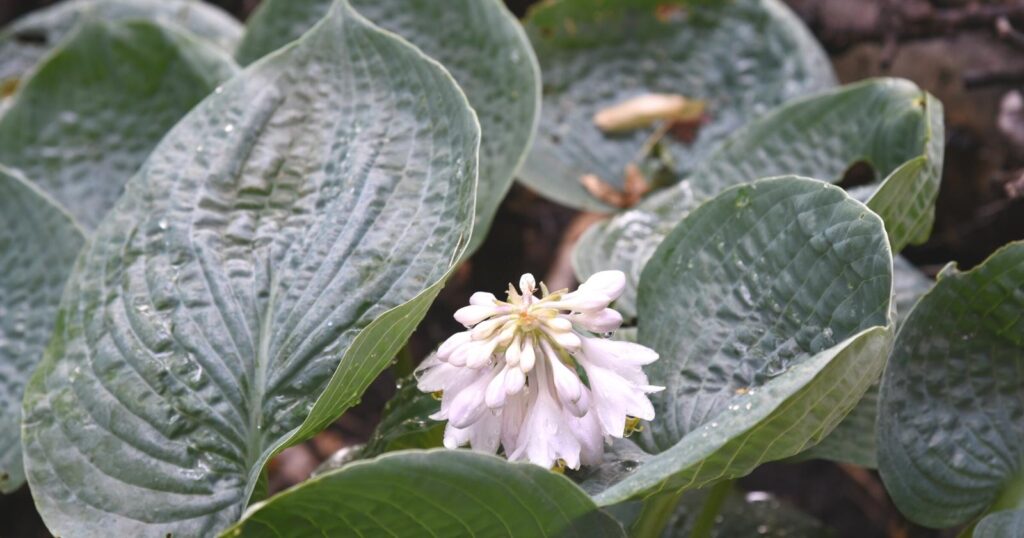
Scientific Name: Hosta
- Sun Exposure: Partial to Full shade
- Height When Mature: 2″ to 60″ tall
- Soil pH: 6.5 to 7.5
- Plant Zone: 3 to 9
I love hostas. They are one of the most reliable perennials in a zone 3 garden. There are also hundreds of unique varieties to choose from.
Hostas are shade loving plants, they can take shade-part sun. Blue colored hostas can take more shade, whereas light green colored hostas like more sun. They grow best in moist, fertile, well draining soil.
In a zone 3 garden, hostas are one of the last plants in the garden to emerge. I generally plant bulbs in between my hostas. Allium and tulips are great choices. They flower before the hostas emerge and fill the space.
‘Sum and Substance’ is one of my go to varieties in zone 3. It grows big and lush with golden chartreuse leaves. It can handle more sun than some of the blue and dark green varieties.
‘Mouse Ears’ is a great dark blue variety. It is miniature and perfect to tuck into small shady corners and nooks.
‘Patriot’ hosta has green interior and a big white margin. It grows big in zone 3 gardens. The foliage is a great contrast and stands out in shady areas.
‘Jack Frost’ Brunnera
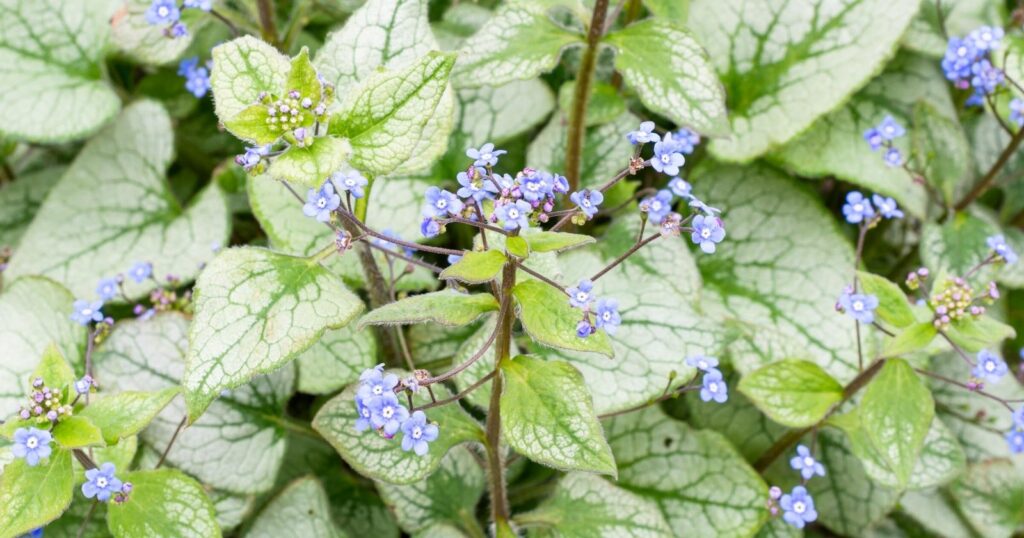
Scientific name: Brunnera macrophylla ‘Jack Frost’
- Sun Exposure: Partial shade
- Height When Mature: 1.5′ tall, 1.5′ wide
- Soil pH: 5.5 to 6.0
- Plant Zone: 3 to 8
I like a lot of varieties of brunneras, but ‘Jack Frost’ has to be my favorite. This shade loving perennial is striking. They have heart shaped leaves that are frosted a beautiful silver color. It then has dark green veins running through the leaves. It blooms little mauve flowers in the early summer.
I love placing a few of these amongst my hostas for a great foliage contrast. They like the same shady conditions and moist rich soil that hostas like so it’s a match made in heaven.
Joe pye weed
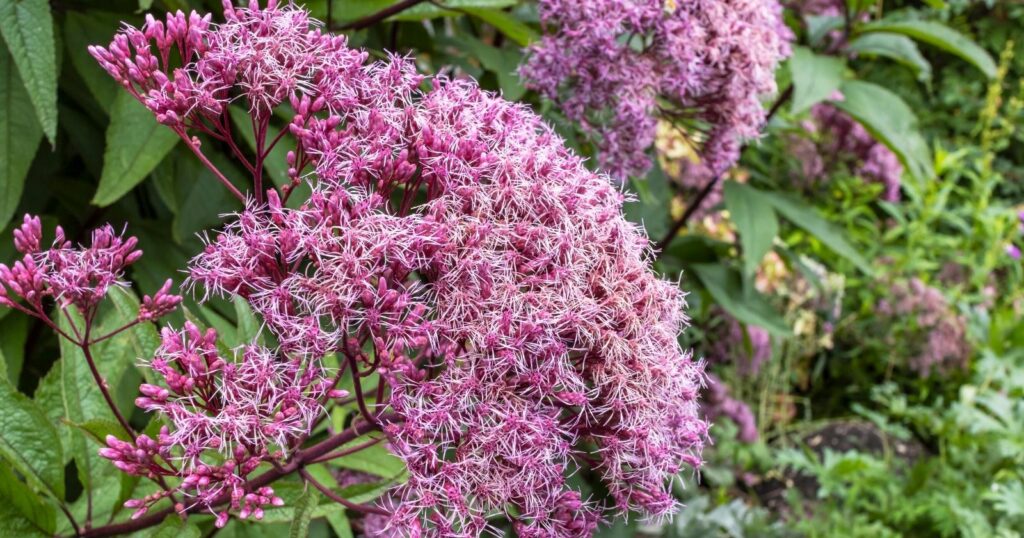
Scientific name: Eutrochium purpureum
- Sun Exposure: Partial sun to Partial shade
- Height When Mature: 5′ to 7′
- Soil pH: 5.0 to 8.0
- Plant Zone: 4 to 8
Joe pye is a statement plant in a garden. It grows over 6′ tall in a single growing season. Then it is cut back to the ground and regrows again. It has sprays of fluffy pink flowers that bloom in early fall on top of lovely thick dark stalks and pointed leaves. The bees love it. It adds dramatic height and soft textures into the garden.
Plant Joe in a part shade/sun location. This plant needs a lot of water. A boggy patch in your garden, perhaps under the downspout, is a perfect location to plant Joe pye weed.
‘Baby Joe’ is a dwarf variety. You still get the same blooms, but on a much shorter 3-4′ plant. Making it great to add to mixed borders.
Karl Forester grass
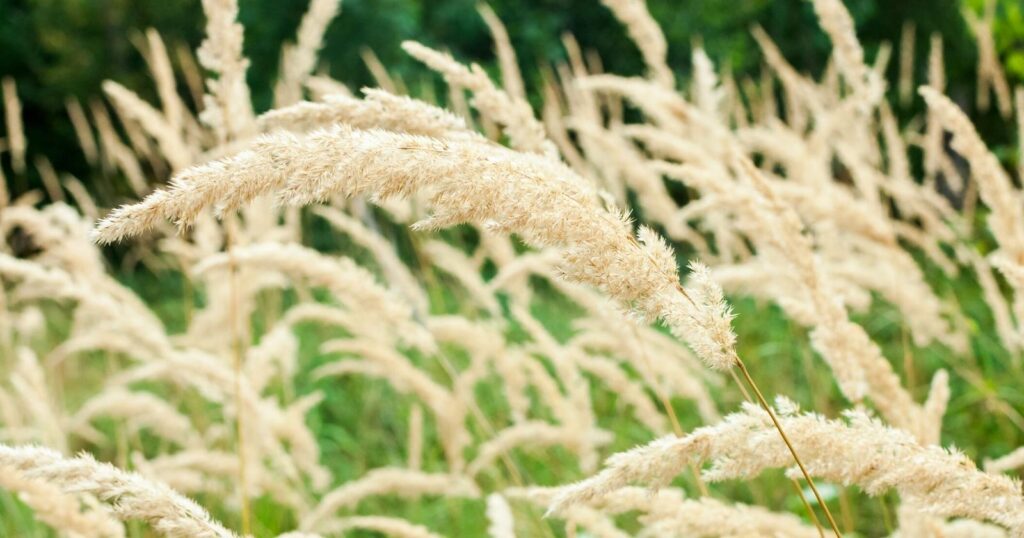
Scientific name: Calamagrostis × acutiflora ‘Karl Foerster’
- Sun Exposure: Full sun to Partial shade
- Height When Mature: 2′ to 3′ tall
- Soil pH: 6.0 to 7.5
- Plant Zone: 5 to 9
Karl Forester grass are super popular in zone 3 gardens. They form a perfect round bunch of wheat-like grass. I see it planted as borders, planted as pops throughout gardens, and planted in masses. I’ve even seen it planted so that it hides an unsightly utility box.
This grass grows straight up like wheat through the spring and summer. Its delicate blades and seed heads blow gracefully in the wind. It needs full sun and moderate water.
What I like about Karl Forester grass is that it stays up all winter. Winter interest is a big deal in a zone 3 garden since so much of our time is spent in winter. While most perennials die back to the ground, Karl Forester grass stays intact all winter. Then I cut it back to the ground in the spring for it to regrow.
Lady’s mantle
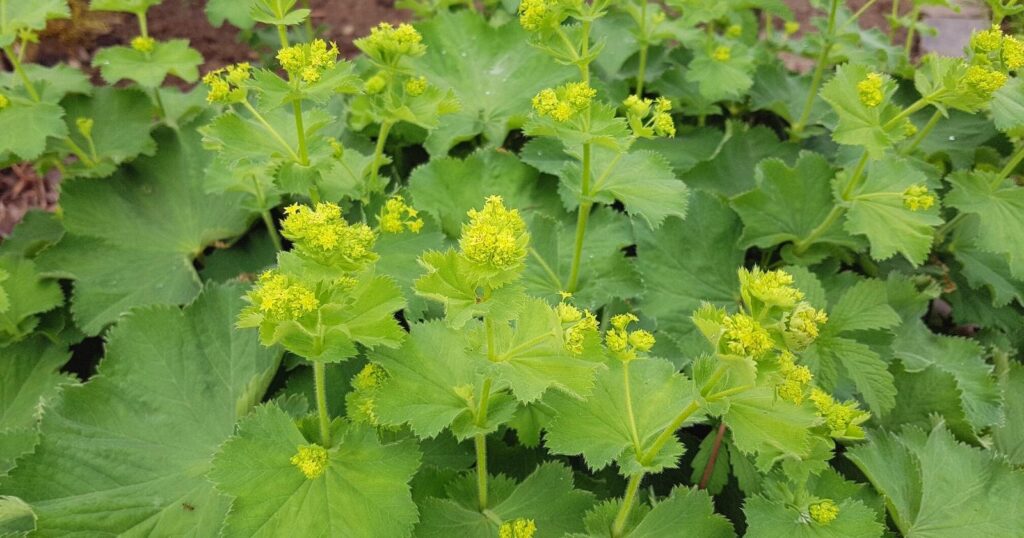
Scientific name: Alchemilla vulgaris
- Sun Exposure: Full sun, Partial shade
- Height When Mature: 6 to 12″ tall
- Soil pH: 5.5 to 7.5
- Plant Zone: 3 to 7
There is nothing quite like the way dew droplets sit in the leaves of a lady’s mantle plant. Like crystal orbs reflecting in their pockets of leaves.
Lady’s mantle is a lovely little shade plant that grows vigorously. It has ruffled green leaves in the spring that catch water droplets. Then it blooms plumes of wispy mustard yellow flowers. I sometimes cut off these flowers because I enjoy the foliage more. But the flowers I will use as an alternative to baby’s breath in bouquets.
Lady’s mantle can spread and be slightly aggressive. It will need to be managed and contained a bit. Luckily it is easy enough to dig up and remove from unwanted areas.
Lamb’s Ear
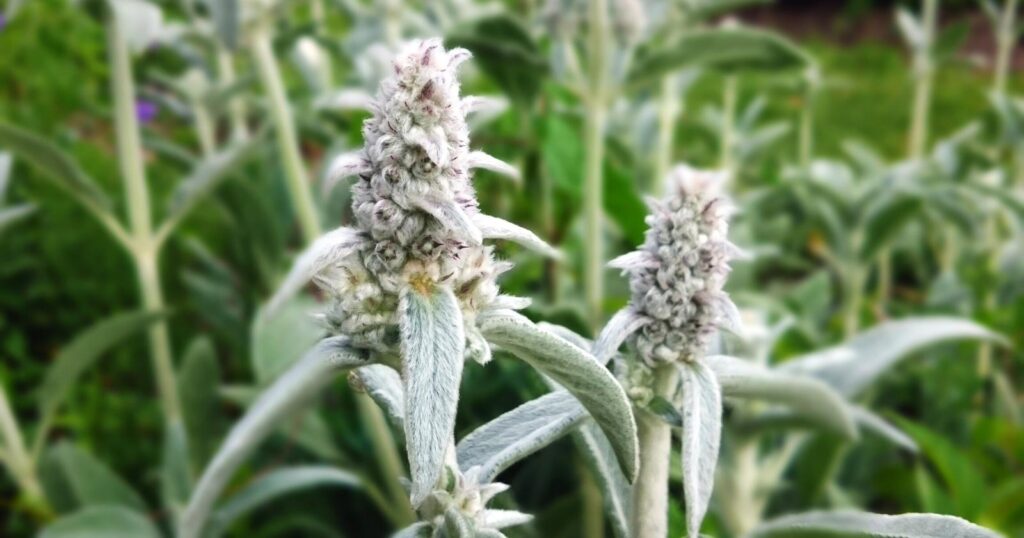
Scientific name: Stachys byzantina
- Sun Exposure: Full sun to Partial shade
- Height When Mature: 6-8″ tall
- Soil pH: 6.0 to 6.5
- Plant Zone: 4 to 8
Lamb’s ear is a lovely garden plant. It has low growing silvery fuzzy foliage which resembles, well, a lamb’s ear. It blooms thick stalks of pink flowers which bees love.
Lamb’s Ear is a great xeriscaping option. It thrives in full sun and dry conditions. It looks great in rock gardens and as a border perennial.
Ligularia
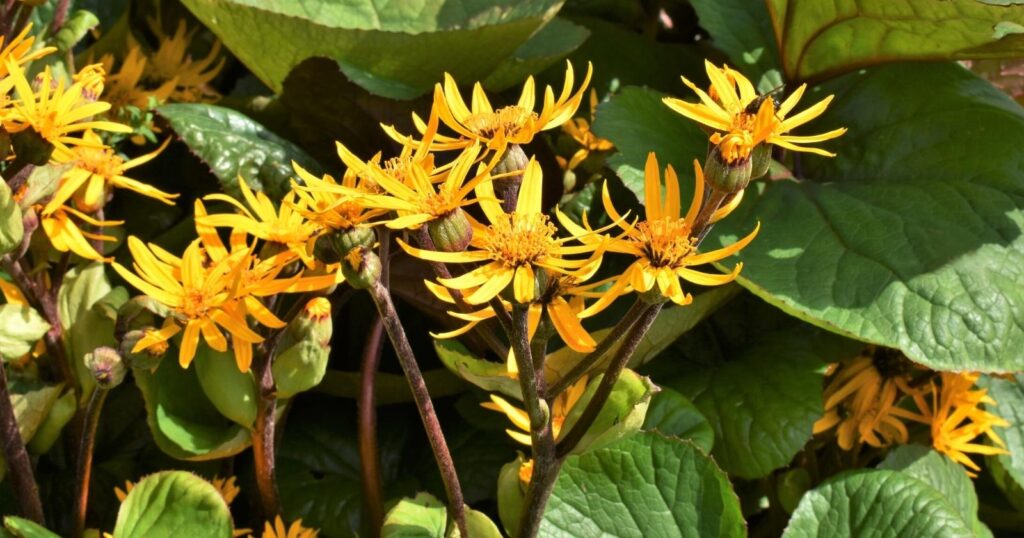
Scientific name: Ligularia
- Sun Exposure: Partial sun, Full shade
- Height When Mature: 3-4′ tall
- Soil pH: 6.0 to 7.5
- Plant Zone: 4 to 8
Ligularia is a big shade and water loving perennial. This large leaf perennial grows up to 5′ tall in a single season. It has big leaves and bright yellow flowers that bloom in mid-late summer. Plant in a part sun-shade area of your garden. Ligularia likes nice rich soil and a lot of water.
This plant will droop and pout and look dead if it dries out. Once you water it it will perk back up. I’ve seen them grow in full sun locations as long as they are getting a lot of constant water. Near a downspout is perfect.
‘The Rocket’ is probably my favorite variety of ligularia. It features jagged leaves and spires of yellow flowers.
‘Othello’ is another variety I like. It has large round lily pad leaves with burgundy underside and stems. It features clusters of yellow daisy like flowers.
Lily of the Valley
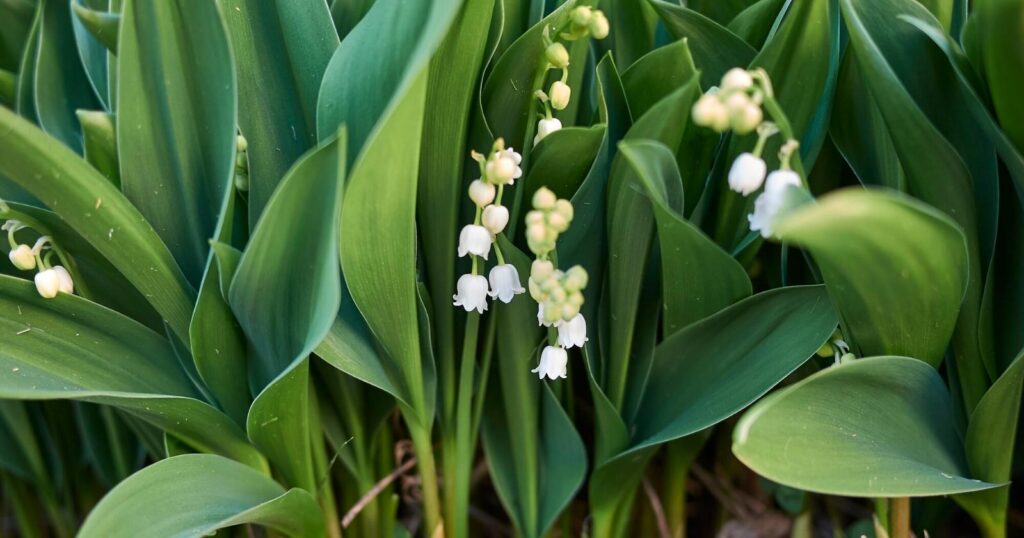
Scientific Name: Convallaria majalis
- Sun Exposure: Partial sun to Full shade
- Height When Mature: 6-12″ tall
- Soil pH: 4.5 to 6.0
- Plant Zone: 3 to 9
Lily of the valley has a time and a place. I would not recommend it for a lot of gardens. It is aggressive and will take over everything if you let it. It has a thick matting of coarse rhizomatous roots that are tough and hard to remove.
Okay, after that rave review you’ll find it hard to believe that I actually do love and use this plant in gardens. It had a fragrance you can’t beat when it blooms in the spring.
It also grows in areas where nothing else will. That is why I use it. Under spruce trees, in the shade, in large spaces that need filled. It spreads and creates a thick mat that weeds do not penetrate. So if you want something low maintenance, plant lily of the valley.
It grows best in part sun-shade and does not care about soil quality. You probably don’t have to buy this plant from the garden center. Your neighbors will probably be glad to dig some out for you. Plant with caution. Find a place where it can spread freely without choking out other plants.
Lovage
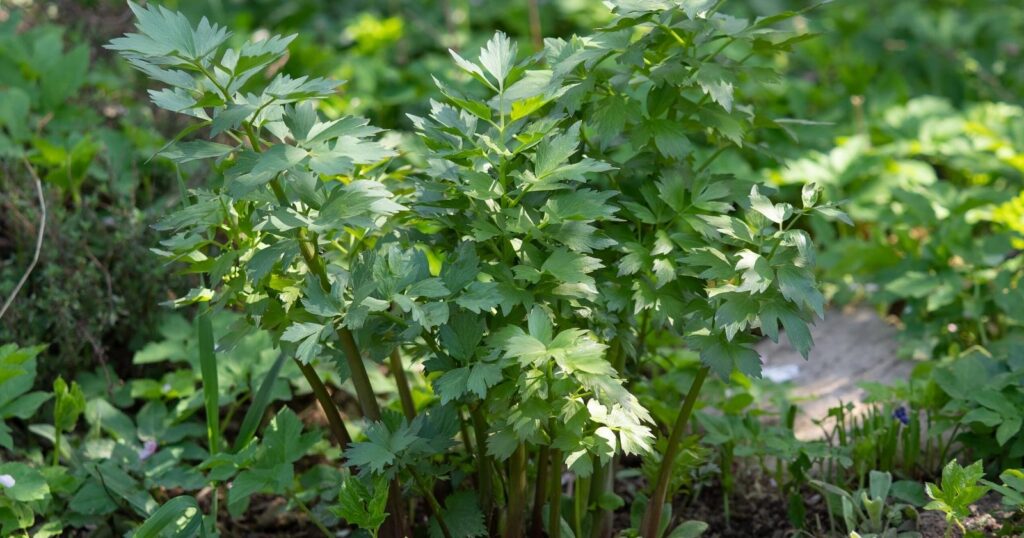
Scientific name: Levisticum officinale
- Sun Exposure: Full sun, Some shade
- Height When Mature: 5 feet
- Soil pH: 6.0 to 7.0
- Plant Zone: 3 to 9
Lovage is a great zone 3 perennial herb. It pops out of the ground in the very early spring and has celery like foliage. It’s a great space filler in the garden. It provides a nice texture of lacy green foliage as a backdrop for other flowering perennials to shine against.
Lovage likes full-part sun and light well draining fertile soil. As a bonus, lovage can be trimmed and used as a herb in soups and stews. It has a celery taste with hints of parsley and anise. It is delicious.
Lungwort
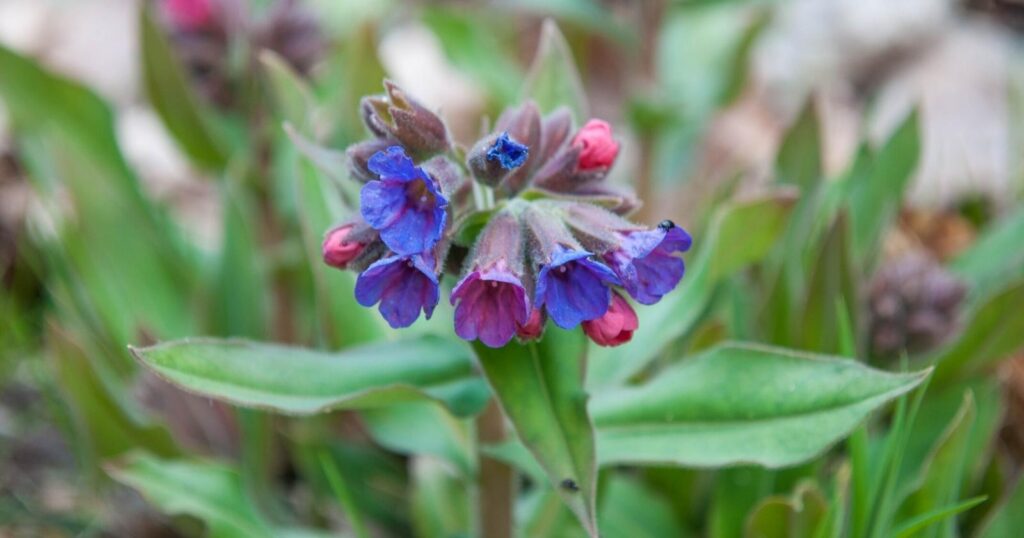
Scientific name: Pulmonaria officinalis
- Sun Exposure: Partial sun, Full shade
- Height When Mature: 6-12″ tall
- Soil pH: 7.0 to 7.5
- Plant Zone: 3 to 9
Lungwort is a reliable and hardy ground cover in zone 3 gardens. I see it everywhere. It’s another very early spring bloomer. I have seen the little pink and purple bell flowers peeking out of the snow. It like sun-shade gardens and is one of the few perennials that can handle dry shade. Which means it can grow under spruce trees.
It has pointed fuzzy green leaves with spots on it. You will need gloves when handling it as the fuzzy leaves are irritating to the skin. I tuck this hardy ground cover perennial in spaces that won’t grow much else. It does spread, but not aggressively.
I always find later in the season lungwort will get powdery mildew. I take my hedge clipper and clip them down. They will produce a second flush of smaller leaves.
‘Silver Bouquet’ lungwort is a variety I recently started adding to gardens. It stays in a smaller clump and it blends beautifully in a hosta garden. The pointed silver foliage really pops amongst all the green. Add a burgundy heuchera for an even bigger foliage contrast (heucheras are technically zone 4, but I grow them successfully here in zone 3)
Monkshood
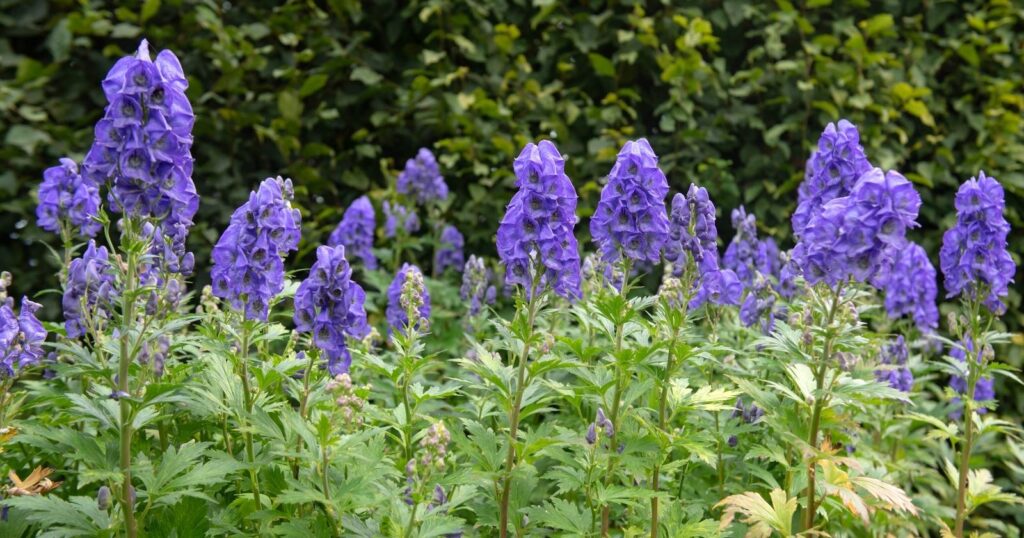
Scientific Name: Aconitum
- Sun Exposure: Partial-Full sun
- Height When Mature: 2-5′ tall
- Soil pH: 5.5 to 7.0
- Plant Zone: 3 to 7
Monkshood has a bit of a bad reputation. It is toxic. Which is something to consider when purchasing any new plant. I will say I’ve grown it in my garden for years with no problem around my pets and young children.
Why I like monkshood is because it fills a bloom gap and is low maintenance. I find there is a lag of blooms between summer and fall in zone 3. Monkshood fills that gap with its late summer blossom. It comes in pink, purple and white. The blooms look like little hooded monks.
It has the same plant structure as delphinium (in fact in early spring they are hard to tell apart). But monkshood are sturdier and usually do not require staking. They also are great for filling a space, they grow quickly.
I plant monkshood along fences and in the back of gardens. They grow best in part sun conditions, with moist fertile soil (although they aren’t too picky). It is also a very deer resistant perennial.
Moss Phlox
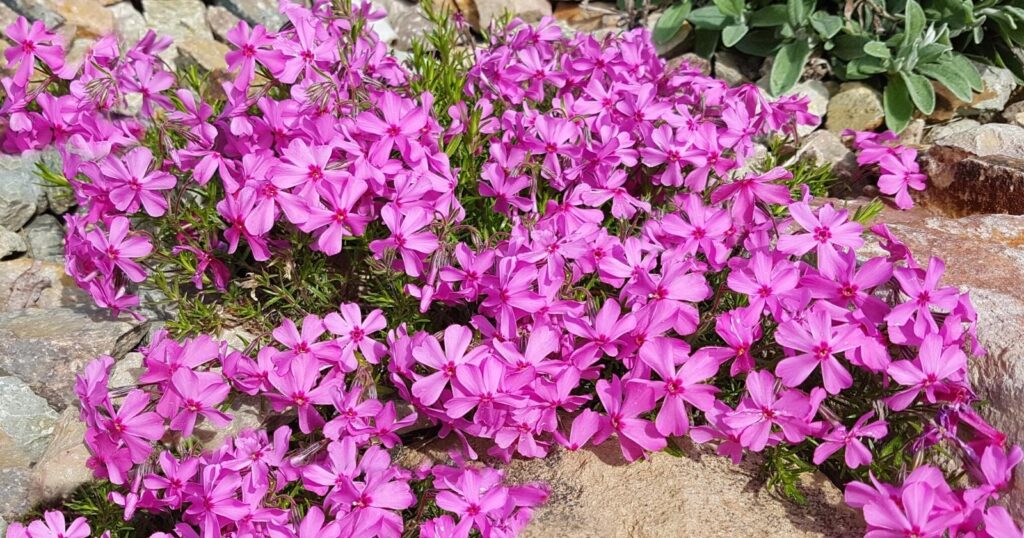
Scientific name: Phlox subulata
- Sun Exposure: Full sun
- Height When Mature: 8″ tall
- Soil pH: 6.0 to 8.0
- Plant Zone: 3 to 9
Moss Phlox is my favorite evergreen ground cover. It has prickly spruce-like foliage that remains green year round. In spring it turns into a carpet of star shaped flowers. It comes in a variety of shades of pink, purple, and white. The the rest of the season it is just a nice green ground cover.
Moss Phlox likes full-part sun locations and well draining soil. It works great in rock gardens.
‘Candy Stripe’ is one of my favorite varieties. They are pretty pink with white margins. It is such a dainty flower to welcome spring.
Oriental Poppy
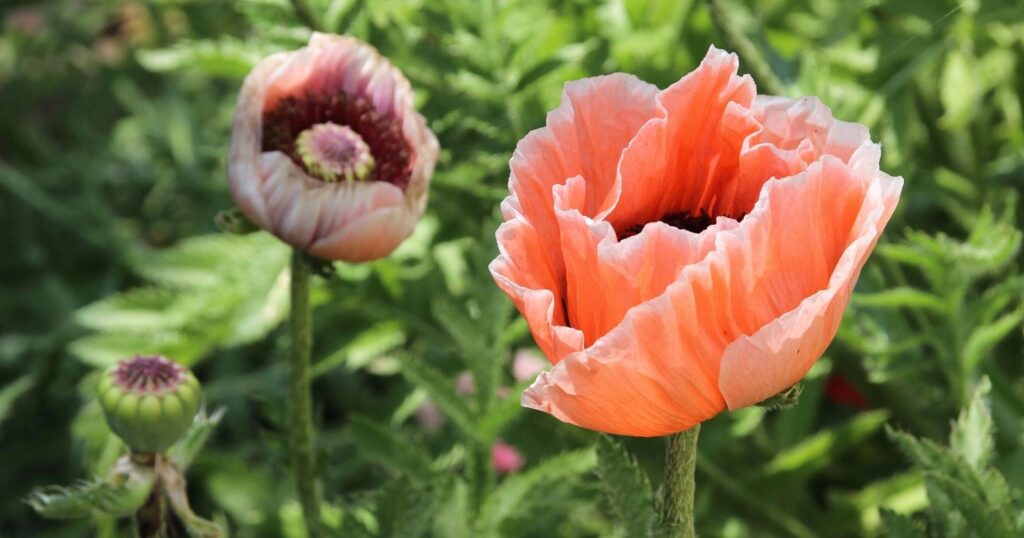
Scientific name: Papaver orientale
- Sun Exposure: Full sun
- Height When Mature: 24″ tall
- Soil pH: 6.5 to 7.0
- Plant Zone: 3 to 8
In the spring, nothing rivals the drama of a huge oriental poppy in full bloom. It emerges in early spring with fuzzy leaves and then long stems grow and out burst a glorious poppy in pink, red, orange, or white. This is a big statement flower. It looks great in garden borders. After it finishes blooming the foliage starts to look scraggly fast. I generally plant it in and amongst other plants so the other plants can quickly conceal it.
Plant oriental poppies in full sun and loose sandy soil for best results. The intricate inner flower of an oriental poppy is amazing. They have big frilly stamens that bees can get lost in. I love this flower.
Ostrich ferns
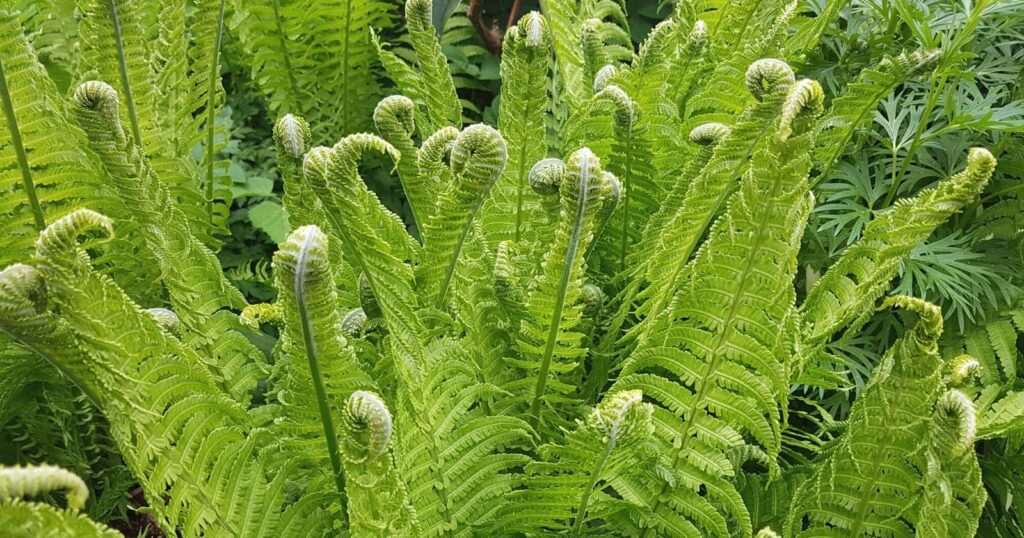
Scientific name: Matteuccia struthiopteris
- Sun Exposure: Partial shade
- Height When Mature: 3-6′ tall
- Soil pH: 5.0 to 6.5
- Plant Zone: 3 to 7
Ostrich ferns are the most common and easy ferns to grow in zone 3 gardens. They like shady damp conditions. They start unfurling in the spring and have tall light green foliage. They spread through spores so they do multiply. If you have too many, or have one growing in a bad spot. Dig it up and replant or give it away.
I find ostrich ferns start to fade away in the late summer. I cut them down then. I leave the dark brown stalks in the center to catch the winter snow.
Pasque Flower
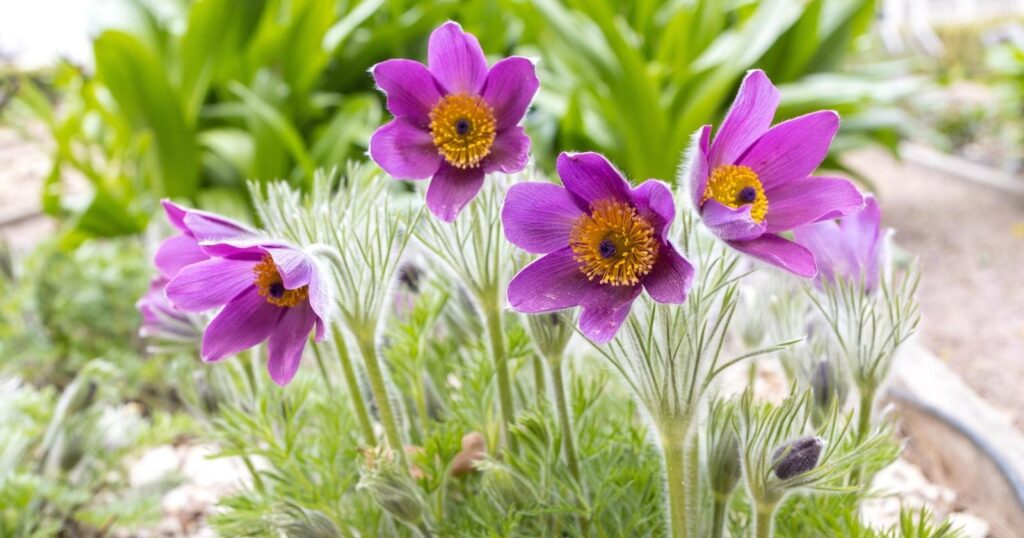
Scientific name: Pulsatilla patens
- Sun Exposure: Full sun
- Height When Mature: 8-12″ tall
- Soil pH: 6.8 to 7.2
- Plant Zone: 3 to 7
Pasque flower, or how I’ve always known it, prairie crocus, is a sure sign spring has arrived. It is the state flower of South Dakota. One of the first flowers to emerge. It is a fuzzy low growing flower that blooms purple. Just add pops of it into your garden and enjoy it in the spring. It will disappear into your garden as the season rolls on.
Pasque flowers grow in full sun and well drained soil. It’s up so early that there won’t be leaves on many of the trees yet, so it can be planted in gardens that get shaded by trees later in the season.
Peony
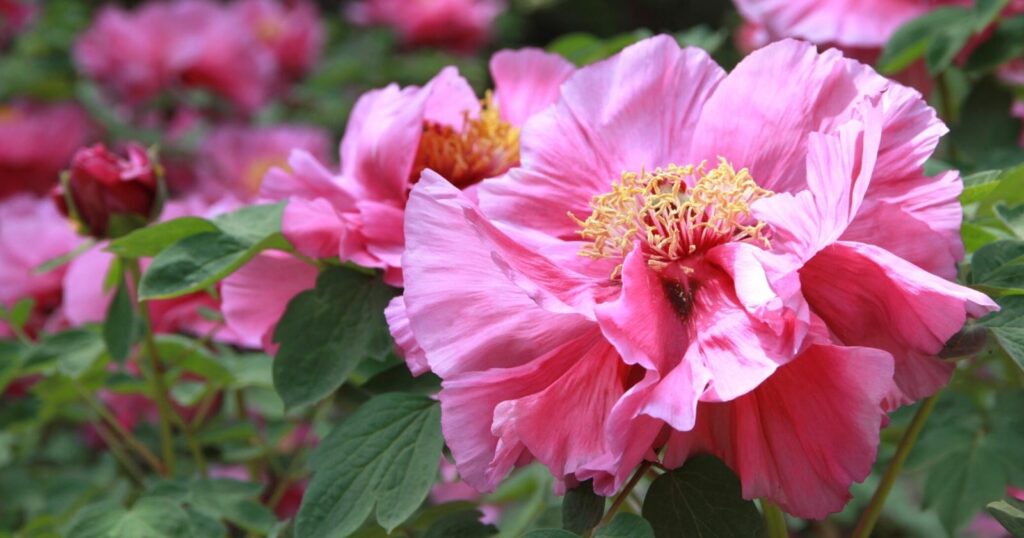
Scientific Name: Paeonia
- Sun Exposure: Full sun, Some shade
- Height When Mature: 3-5′ tall
- Soil pH: 6.5 to 7.0
- Plant Zone: 3 to 8
Peonies grow great in zone 3 gardens. I think we have some of the most gorgeous peonies dripping with flowers because of our cold winter.
Plant peonies in a full sun location. They like well drained soil. Try to provide some shelter from harsh winds and rain. You will most likely need to provide some support for your peony. I use ring cages (like ones you see on tomatoes). I put this on just as the peony is starting to emerge in the early spring.
Tree peony and Itoh peonies are not hardy to zone 3. They are for zones 4-9. But if you have your eye on one, plant it in a protected location and cover it with mulch to protect the roots in the winter. I have seen them over winter here, but they’re expensive, so it is risky.
‘Sarah Bernhardt’ is a classic peony I see in many zone 3 gardens. It has large double flowers if a light cotton candy pink color.
‘Chocolate Soldier’ has a single row of dark merlot petals and a fluffy yellow center. These smaller blooms usually do not require staking.
Plains Prickly Pear Cactus
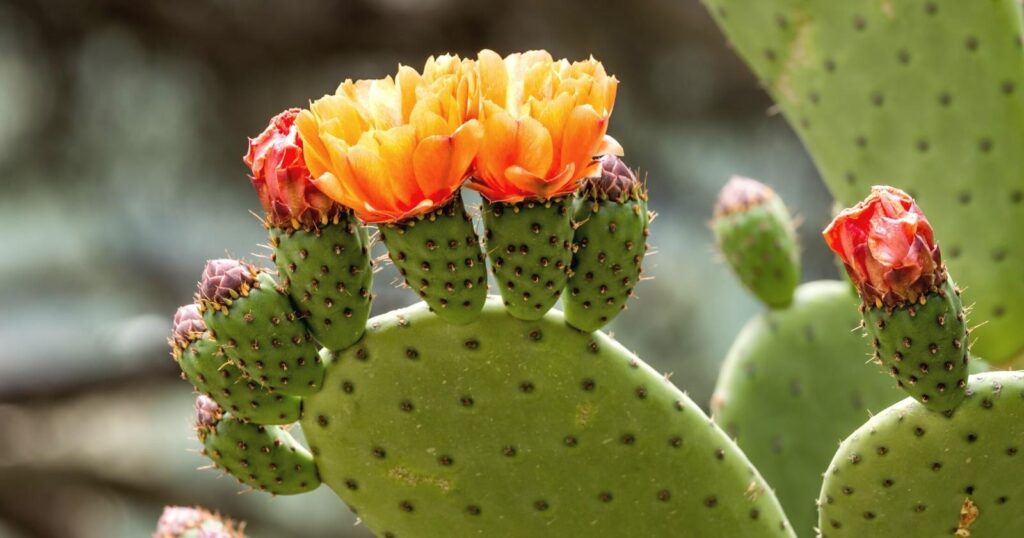
Scientific Name: Opuntia polyacantha
- Sun Exposure: Full sun
- Height When Mature: 1-20′ tall
- Soil pH: 7.0 to 8.8
- Plant Zone: 9 to 11
Yes! We can grow cactus in zone 3! In fact it’s native to areas in North America. There are pink and yellow blooming varieties.
Prickly pear must be planted in full sun and dry and sandy condition in order for it to thrive. Other Than that, just leave it. No need to do anything special to it over the winter. It is a unique plant that will have neighbors admiring it.
When it blooms it is beautiful. Huge bowl shaped blooms on top of small lobs of prickly cactus. It blooms in the summer. Be careful, the spikes are long and sharp.
Rhubarb
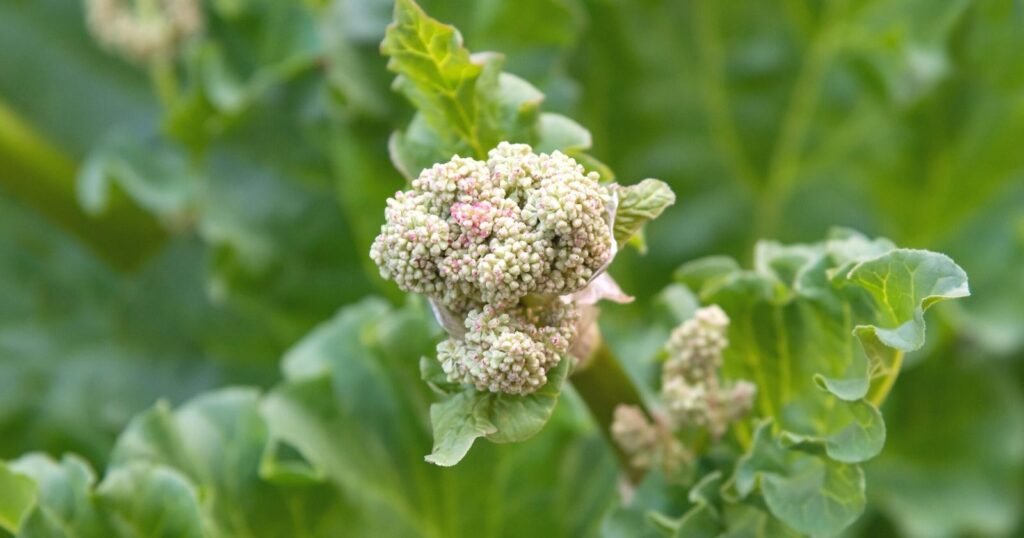
Scientific name: Rheum rhabarbarum
- Sun Exposure: Full sun
- Height When Mature: 2-3′ tall
- Soil pH: 6.0 to 6.8
- Plant Zone: 3 to 8
Rhubarb is a super reliable, super hardy zone 3 perennial. Plus, it’s delicious. My grandma’s rhubarb pie is the best!
The thing about rhubarb is it doesn’t care. Sun-shade, great soil-terrible soil. It doesn’t care. It does sometimes get dismissed as old fashioned. But hear me out. It has lovely red stems and then giant lush leaves that are probably as close as we can get to a tropical alocasia in zone 3. It’s cheap, and easy to find in garden centers or you’ll likely find a neighbor willing to split it. If you have a tricky bare spot that nothing seems to thrive in, try a rhubarb plant.
In zone 3 there isn’t much that will survive above ground over winter. Rhubarb will actually overwinter in a pot. A large planter is best, I see them come back year after year.
Rhubarb does bloom. A huge thick stalk comes out the center and has a knobby fist of white flowers. Remove this to the base of the plant. It’s not attractive and it will make the leaves smaller and the stems tasteless.
Salvia
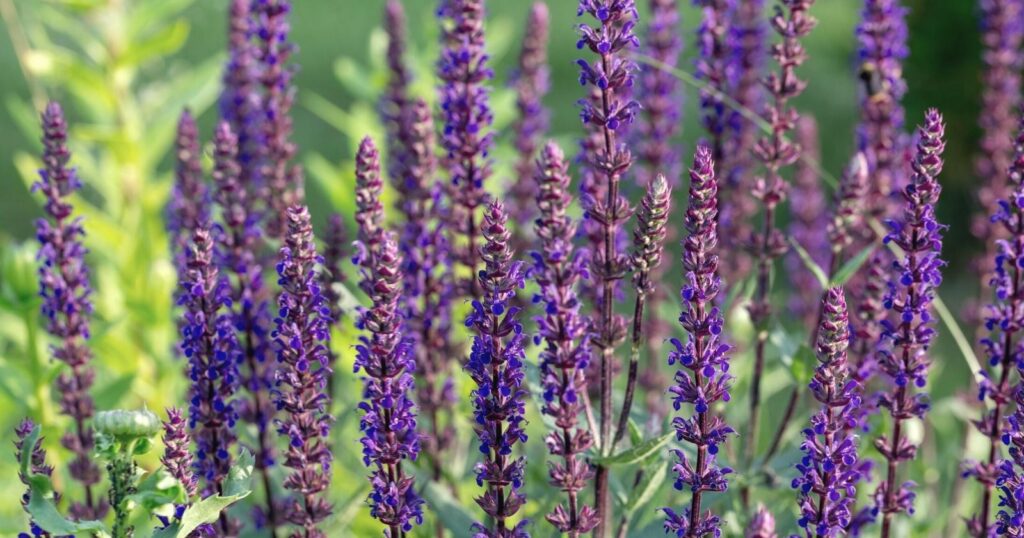
Scientific name: Salvia nemorosa
- Sun Exposure: Full sun to Partial shade
- Height When Mature: 18-24″ tall
- Soil pH: 5.8 to 6.2
- Plant Zone: 3 to 8
Perennial salvia is wonderful for zone 3 gardeners. We cannot grow lavender reliably here (munstead is the only variety of lavender I’d recommend attempting here).
But that does not mean we can’t have spikes of dark purple flowers on spicy scented foliage. Perennial salvia thrives in dry full sun conditions and grows quite large and striking. Bees go nuts for it, it buzzes with life when it blooms in early summer.
I cut down my salvia once it starts looking bad, around mid August. Then I will sometimes get a smaller flush of fall flowers.
Sea Holly
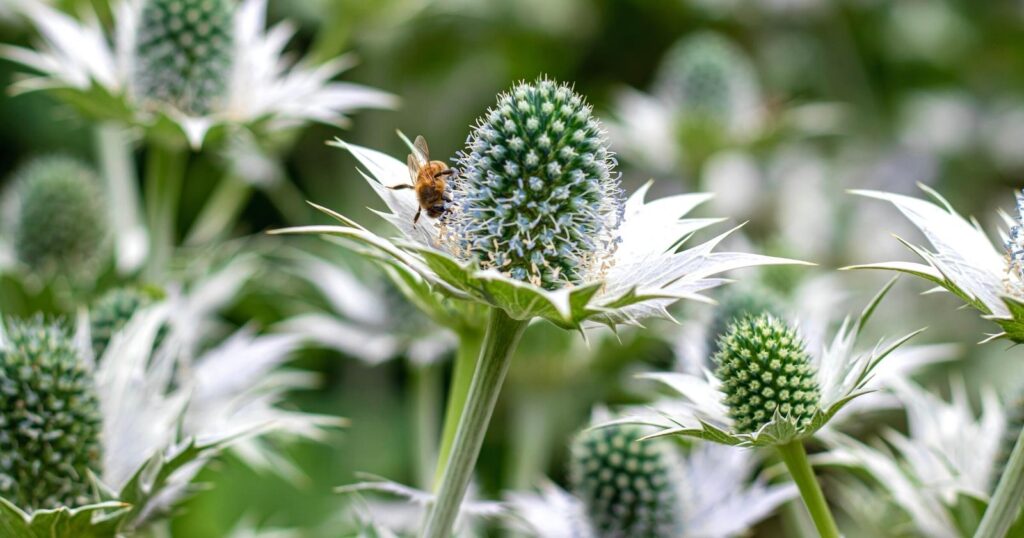
Scientific name: Eryngium
- Sun Exposure: Full sun
- Height When Mature: 25-32″ tall
- Soil pH: 6.0 to 7.5
- Plant Zone: 2 to 10
Sea holly is such a fun perennial. It looks like it’s from another planet. It is a silver foliaged plant with thistle like leaves. It blooms spiky flowers with a round cone center. The blooms look like they are spray painted purple as it blushes purple down the stems.
Sea Holly is a great water wise perennial. It requires little water and full sun. This plant does get bigger and pop up new plants. But it’s fairly easy to manage. Be careful handling this one. It is sharp and thorny, use gloves
It looks great planted in mixed perennial gardens. I especially like it planted with peonies as the silver foliage contrasts with the green peony foliage and then sea holly will bloom after peonies do their thing. When it blooms in the summer months the blooms will stay intact until fall.
Shasta Daisy
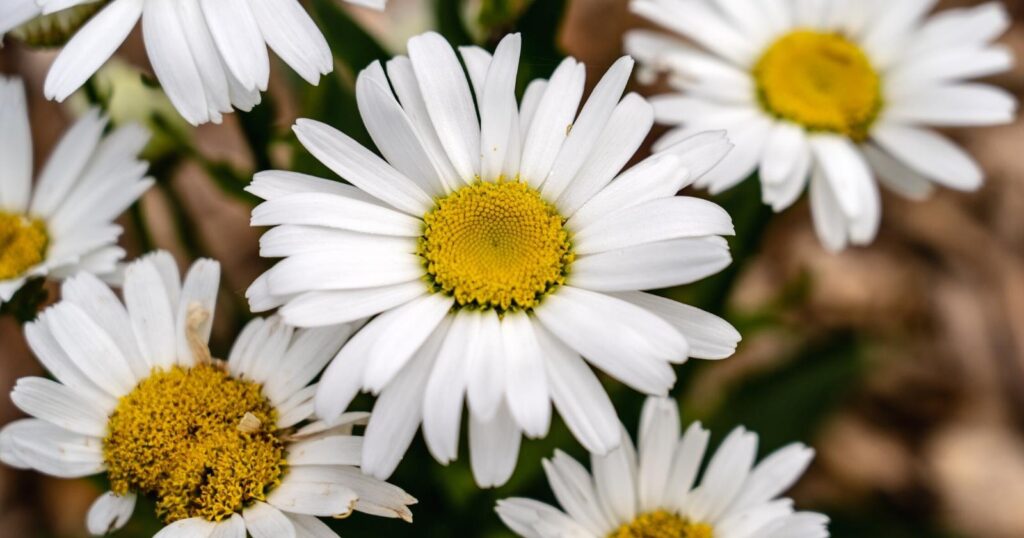
Scientific name: Leucanthemum × superbum
- Sun Exposure: Full sun to Light shade
- Height When Mature: 2-3′ tall
- Soil pH: 5.5 to 6.2
- Plant Zone: 4 to 9
These are not the weedy oxeye daisy that spread through alleys like wildfire. Shasta daisies are a lovely mounding perennial. They are a perfect companion to plant with peonies. They are around the same size and they bloom after peonies have finished, so you have a constant stream of blooms.
They are classic daisy like flowers. They smell a bit bad, but are beautiful sunny cheerful garden flowers. Plant them in full-part sun and in well draining soil.
Silver Mound
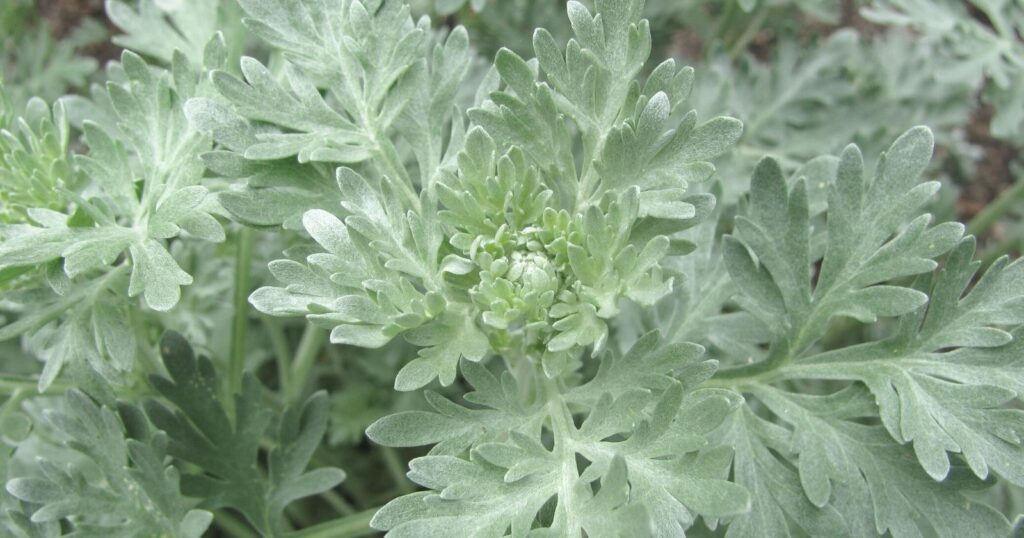
Scientific name: Artemisia schmidtiana
- Sun Exposure: Full sun to Partial sun
- Height When Mature: 6-12″ tall
- Soil pH: 5.5 to 6.5
- Plant Zone: 4 to 8
Silver mound doesn’t get nearly enough credit. I mean it’s not as exciting and glorious as peonies and delphiniums. But it’s hardy, reliable, and provides beauty through foliage.
The light feathery silver foliage of silver mound is beautiful. When you brush up against it it feels velvety and let’s off a spicy aroma. It stays in a perfect mound and is perfect as a formal border plant. It needs full sun and little water. This drought tolerant little plant is a great addition to zone 3 gardens.
Snow-in-Summer
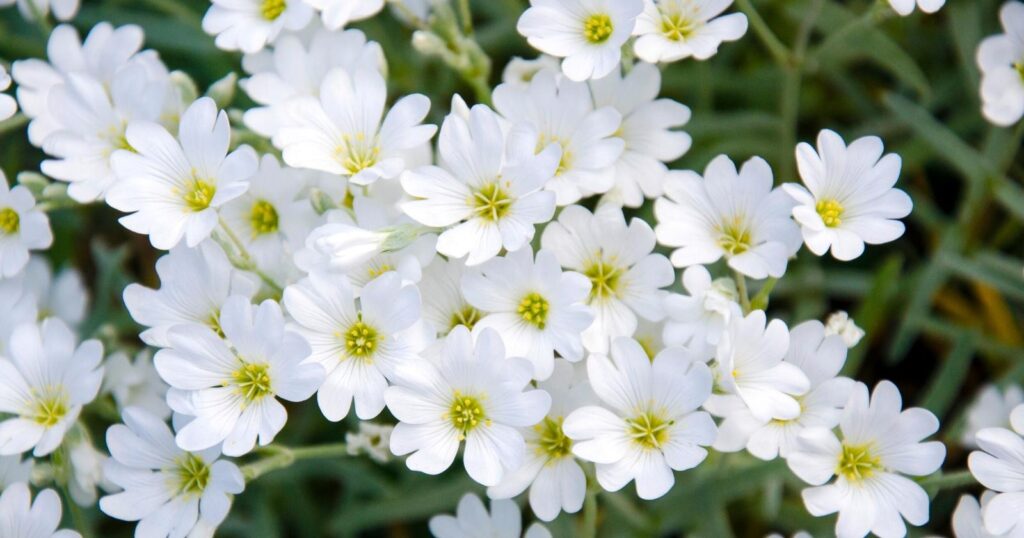
Scientific name: Cerastium biebersteinii
- Sun Exposure: Full sun
- Height When Mature: 6-12″ tall
- Soil pH: 6.0 to 7.0
- Plant Zone: 3 to 7
Snow-in-summer is a lovely little full sun ground cover. It is a silvery color and is covered in white blossoms in the summer. It looks as the name suggests, like snow in the summer. I like planting it on the edges of gardens with rocks, it will creep and pool outward.
Snow-in-summer is a very hardy little perennial. It is drought tolerant and can handle poor soil. Plant it in full sun. It is also deer resistant.
Snow in summer pairs beautifully with richly colored foliage like Sunsparkler ‘Fire Crackers sedum. Or a ‘Crimson Pygmy’ barberry.
Solomon’s seal
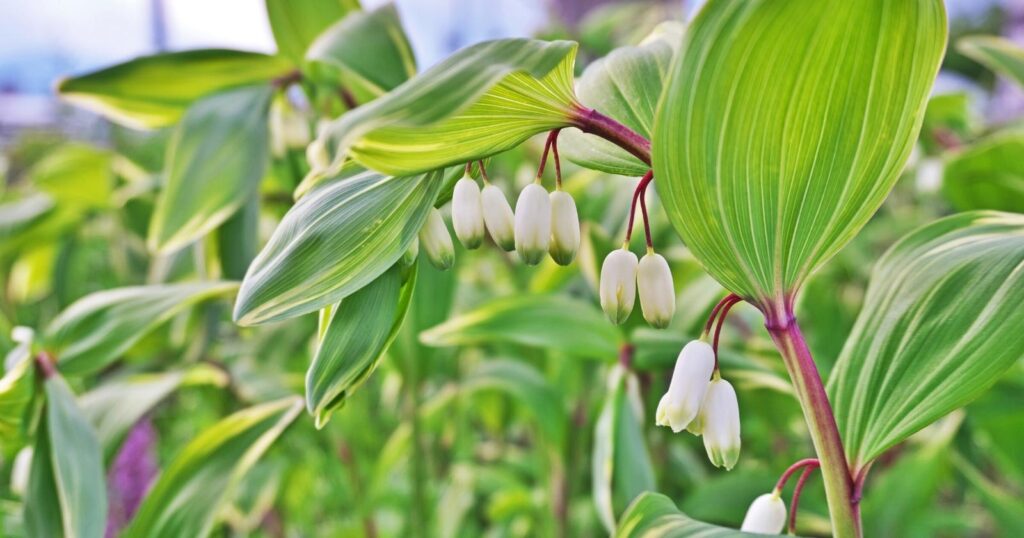
Scientific name: Polygonatum biflorum
- Sun Exposure: Partial to Full shade
- Height When Mature: 3-5′ tall
- Soil pH: 6.0 to 7.0
- Plant Zone: 3 to 9
Solomon’s seal is a lush shady woodland plant. It spreads, but fairly slowly in zone 3 gardens. It comes up as a single stalk with leaves all the way up. Then in the spring it has white bell shaped flowers that dangle along the leafy stem. I don’t know why, but it always reminds me of some strange Jurassic plant.
Solomon’s Seal like lush moist soil and part shade-shade gardens. Mix it with hostas for a height and texture contrast.
Sweet Woodruff
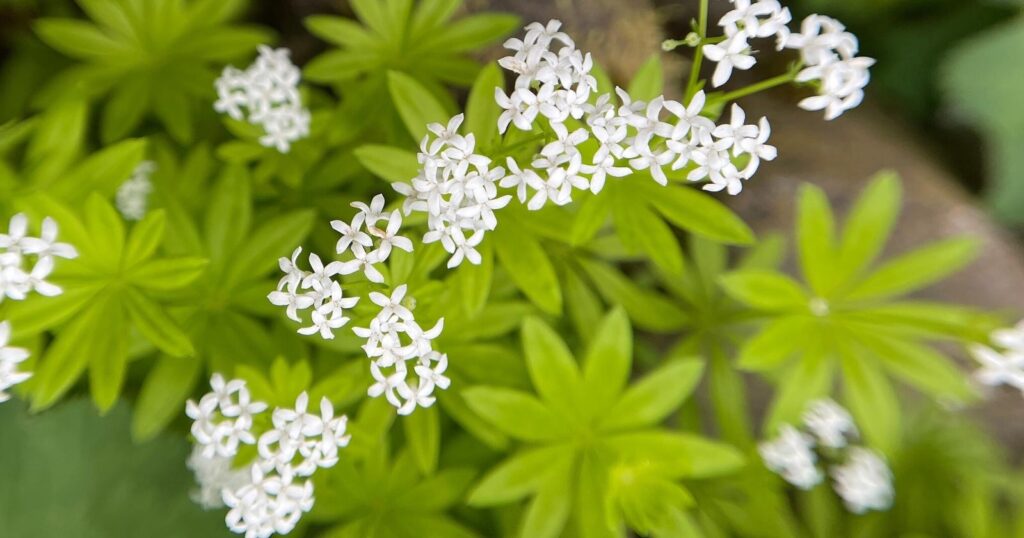
Scientific name: Galium odoratum
- Sun Exposure: Partial to Full shade
- Height When Mature: 6-12″ tall
- Soil pH: 4.3 to 8.3
- Plant Zone: 4 to 8
I love sweet woodruff! It’s one of my favorite ground covers. I like using plants as a natural mulch to keep water in the soil. Sweet woodruff is a great choice. It has small lacy leaves and is covered in white star shaped flowers in the late spring.
Sweet woodruff adds a woodland whimsy into part shade gardens. Plant sweet woodruff in part sun-part shade gardens. It likes lush well draining soil. It pops up underneath hostas, ferns, rhubarb, and other shade loving plants. It does spread, but I don’t find it over aggressive in a zone 3 garden. It also transplants like a dream. It has shallow roots that you just dig up and stick somewhere else. It doesn’t even droop or pout.
Final Thoughts
People always ask me if I wished I lived in a warmer garden zone. I may have at one time said yes I’d trade for a zone 6-7 garden. But now that I’ve been living and working in this zone for decades, I can’t imagine gardening anywhere else.
As you can see we gave a long list of gorgeous perennials (and there many, many more) to choose from. The list of trees and shrubs available to zone 3 is equally as long. So have fun adding and experimenting with hardy zone 3 perennials in your garden to create a lush and interesting landscape.

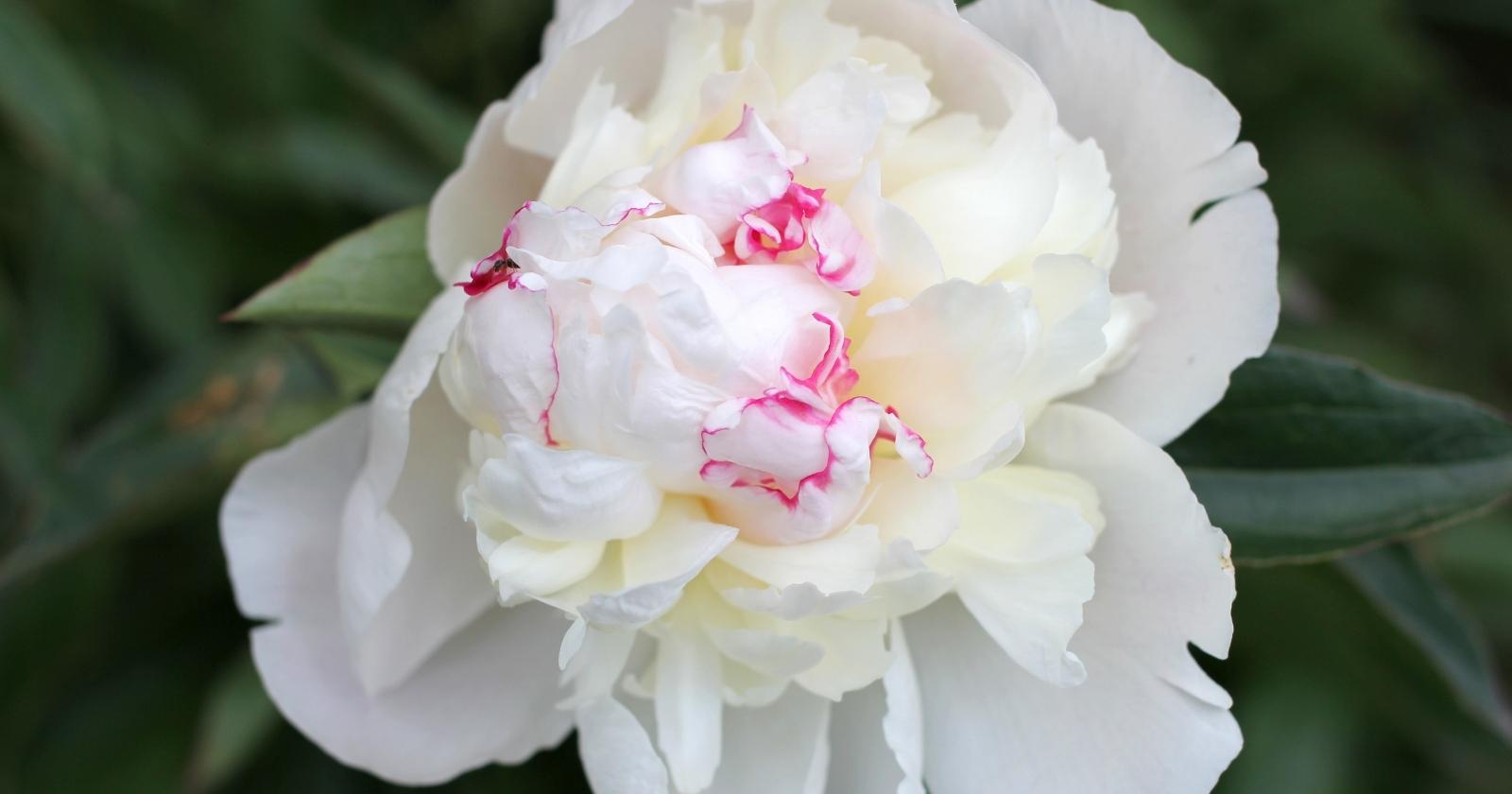
Leave a comment